OHIO today

SPRING 2025
Level Up
From team-building to networking, esports goes beyond video games
Atomic Breakthrough
Imaging tiny particles has massive implications for scientific research


SPRING 2025
Level Up
From team-building to networking, esports goes beyond video games
Atomic Breakthrough
Imaging tiny particles has massive implications for scientific research
Greetings, Bobcats!
It has been an amazing fall at OHIO. We celebrated many important milestones, including a significant increase in total enrollment, climbing more than 1,300 students to 29,625 for a 4.6% gain over last year.
We saw growth in both undergraduate and graduate enrollment on the Athens campus, overall enrollment growth on our regional campuses, significant growth in OHIO Online undergraduate programs, and a modest gain in enrollment across our three-campus medical school. Additionally, first-year to second-year retention on the Athens campus jumped significantly to 84.1%, a two-decade high.
We were proud to learn that for the fifth consecutive year, U.S. News & World Report named OHIO as the best value public university in the state of Ohio and No. 26 best value public university in the nation, cementing our position among the country’s top institutions.
We are now moving plans into action with our Dynamic Strategy—to lean into our strengths in ways that elevate our reputation. We will share our progress this spring.
In February, we partnered with the National Academy of Engineering to name Ian A. Shanks of the
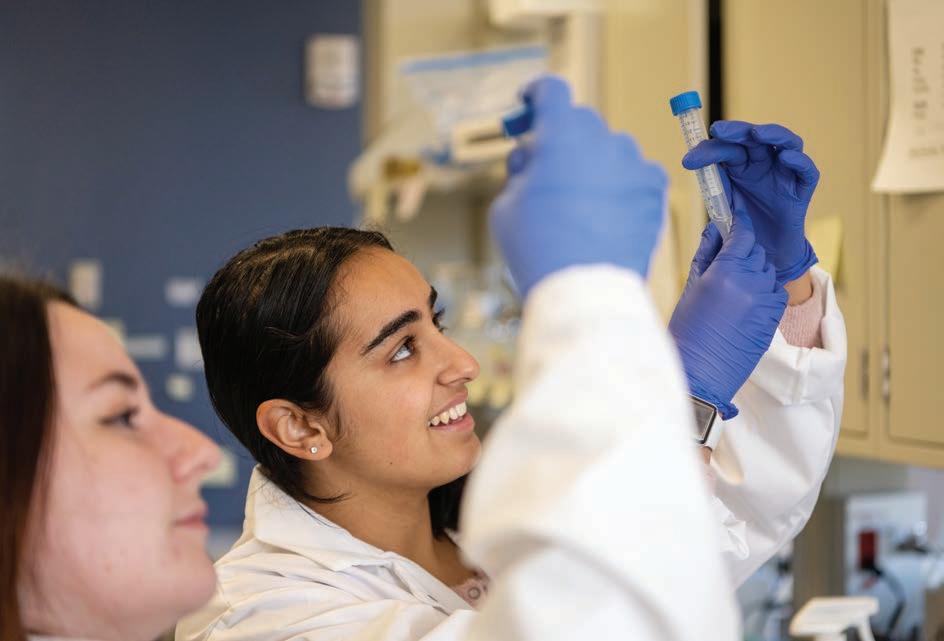
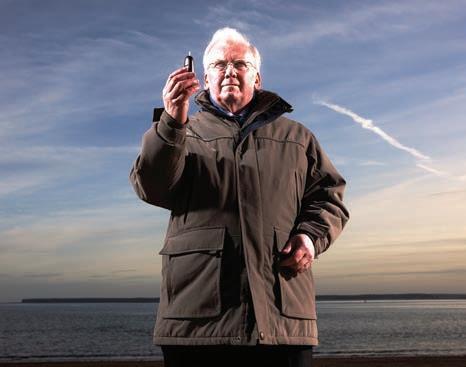
FROM PRESIDENT LORI STEWART GONZALEZ
Ohio University’s Heritage College of Osteopathic Medicine (HCOM) received an $8 million grant from the National Institutes of Health to help fund the new Heritage Translational Research Center (HTRC), which broke ground in early 2025 on the Athens campus. The center will consolidate research currently spread across campus, fostering collaboration between scientists and supporting initiatives like the Diabetes Institute and Ohio Musculoskeletal and Neurological Institute (OMNI).
University of Glasgow as the 2025 recipient of the Fritz J. and Dolores H. Russ Prize, which recognizes an outstanding bioengineering achievement in widespread use that improves the human condition. Shanks is recognized for the invention of the electrochemical capillary fill device (eCFD), which gives diabetes patients and caregivers accurate and timely blood glucose measurements for diabetes management. This year’s award is particularly meaningful to us as a national research institution situated in the Appalachian region, where the prevalence of diabetes surpasses national averages.
In March, we hosted the Higher Learning Commission on our Athens campus for our 10-year accreditation review, which helps maintain the integrity and credibility of our institution. This review gives us the opportunity to showcase all the amazing initiatives in place that create extraordinary academic experiences for our students.
I’m so proud of the successes our students, staff, faculty and alumni continue to achieve, and I look forward to continued progress and success this coming year.
Lori Stewart Gonzalez President

Christian Drischler, assistant professor at Ohio University, was awarded the prestigious National Science Foundation CAREER Award. It will support his research and educational initiatives in theoretical nuclear physics and nuclear astrophysics, including outreach to the Appalachian Ohio community to increase public understanding of nuclear science and inspire future STEM students.
Three Ohio University faculty members received the Journal of Rural Health’s “Article of the Year” award for their study on how critical access hospitals can improve health equity by addressing social determinants of health. Read more about this honor on page 18.
Ohio University’s Voinovich School of Leadership and Public Service won two of the three 2024 Impact Awards from the National Association of Development Organizations (NADO) for its significant contributions to regional development. The awards recognized the Resilience Initiative for Southeastern and Eastern (RISE) Ohio project, which supported economic transition in Appalachia, and a climate change preparedness project that enhanced the region’s response to flooding and extreme weather.

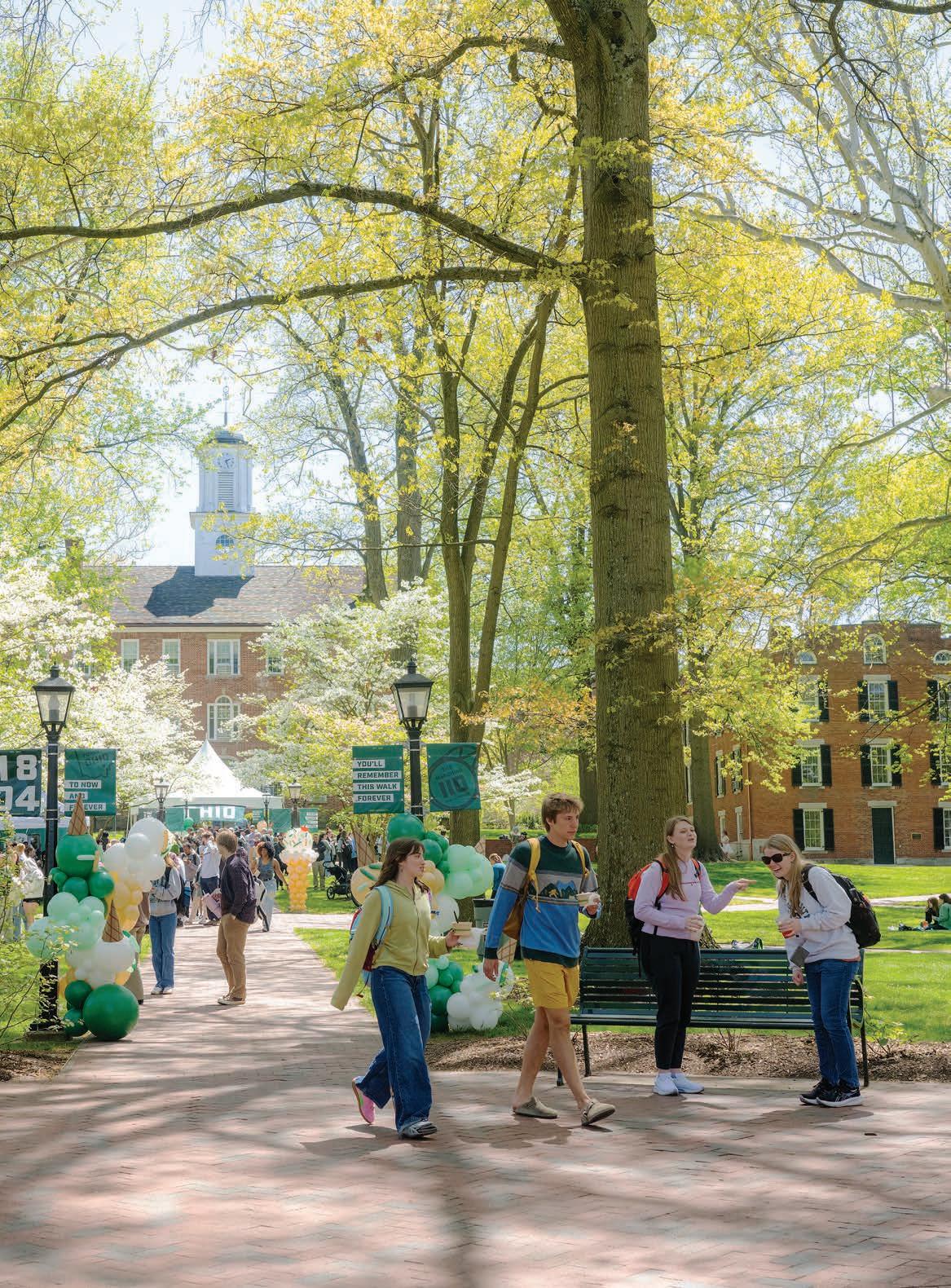
ON THE COVER OHIO’s esports program is growing, both academically and as an extracurricular club. Read about the program’s benefits for students on page 12.
[THIS PAGE] Students, faculty and staff gather for an ice cream social hosted by President Lori Stewart Gonzalez and her cabinet on College Green last spring.
BY RICH-JOSEPH FACUN, BSVC’01
“Rock On” keeps rockin’ I enjoyed reading “Rock On, Athens” (spring 2024), as I attended many concerts during my time as a student. I, too, have several posters and ticket stubs from that timeframe, including the 1973 Ohio University Music Festival poster. Jonathan Edwards was on that bill; in 2016, I surprised him with a copy of the original poster at a show in Rio Grande, Ohio—and he signed my copy.
I have fond West Green memories of living and jamming with other musicians in Grosvenor Hall. Fiftytwo years later, I’m still in the music business as a musician, booking agent and promoter. I’ve been blessed to work with hundreds of acts and watch several of them become superstars, including Taylor Swift; Randy Travis and the late Charlie Daniels became good friends, along with many others. Although I graduated with an education degree, my passion was music. I’m thankful that a part of that started in Athens. —Chuck Lipps, BSED ’76
“Rock On, Athens,” brought back a lot of memories of music acts while I attended OU from 1967-71. This was the height of the British Invasion and psychedelic rock. Walking across the West Green, one could hear all manner of music pouring out of the open windows, from Ten Years After, Moby Grape, Small Faces, and of course, The Beatles and The Rolling Stones.
But the weirdest concert I have ever seen occurred my freshman year in Mem Aud, by The Grateful Dead. The lights went down, and you could see a lot of movement
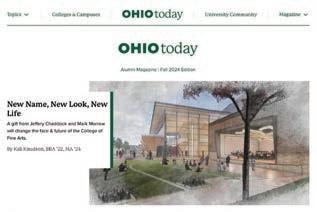
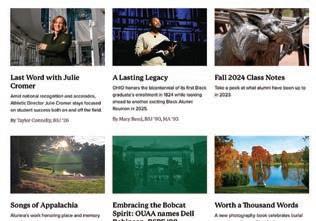
across the stage. The lights were slowly brought up to maybe a quarter intensity to reveal a live goat, a live sheep, two drum kits, a nursing mother and at least a dozen other people just milling around the musicians. The set started, the milling people kept milling, the goat and sheep lasted most of the set, and The Dead did what The Dead does. It was a strange, sometimes fraught, wonderful time to be in college, and OU was front and center. Thanks for sparking those memories with the article. —Ron Rychener, AB ’71
My fondest musical memories at OU include a concert with Paul Revere & the Raiders. I recall going to Club 33 after the concert; Paul and several Raiders were there too, and I danced the Pony with Paul on a big table! Wild child. OU never, ever skimped on its concerts. We always had the best, at the height of their popularity. —Connie (Justice) Crowther, BSJ ’66, via Facebook
Showcasing the power of innovative storytelling, the University Communications and Marketing (UCM) team took center stage at the 2024 Education Digital Marketing Awards. They claimed 13 honors and more gold than any other university—including for the new OHIO Today Magazine website, which launched last fall. Check it out and read about UCM’s wins at ohio.edu/magazine.
My husband & I are always eager to peruse OHIO Today Magazine as soon it arrives. We appreciate all your hard work to make it an excellent publication. If only it came out more often! Because so many alumni live far from Athens, it’s a muchappreciated way to stay connected.
As an avid poster collector, I was especially pumped to read “Rock On, Athens” in the spring 2024 edition, and I was shocked to see a poster of mine! I collected (swiped off a wall) the George Clinton poster on a weekend my husband and I went to Athens for the OU/ Miami football game. The very cool poster was framed and hung on the wall of my home for many years.
Last fall I donated a bunch of my memorabilia to the Mahn Center for Archives & Special Collections— including that poster. I was so glad to see it being shared with fellow alumni. Keep up the good work! —Kathleen “Benn” Bennett, BSED ’70
Team spirit
I’ve been happy to see all the fanfare about the 2024 football season; our first MAC Championship since 1968 is long overdue. (Editor’s note: Read about the historic win on page 18.) In my freshman year, the team also won the MAC—and in my junior year, they went 0-10.
The ninth game that year was at home against Bowling Green. Coming out of the locker room after a strong first half, the team paused at the edge of the field. What happened next was one of the greatest spontaneous shows
of support I’ve seen in my long association with sports: Students ran across the field and formed two lines for the team to run through. Their cheers sent an implicit message: “Keep your heads up. You’ve had a tough year, but you’re part of us, and we salute you for continuing to play hard.” I still get a warm feeling just thinking about that gesture.
—John “Russ” Hamilton, BBA ’67
Unlike any other Born and raised in Athens, Ohio, and went away for 42 years. Most of that time was spent in Los Angeles and then Albuquerque. I have never seen a community,
such as the case with Southeastern Ohio, that gives back so much. This part of the country is truly the best place to live in America. My hat’s off to The Sugar Bush Foundation for doing what they do (“Waste Not,” spring 2024). —John O’Neal, AB ’82, via Facebook
WRITE TO US: OHIO Today Magazine welcomes comments from readers. We reserve the right to edit for grammar, space, clarity and civility. Send letters by email to ohiotoday@ohio.edu or by mail to OHIO Today Magazine , Ohio University, P.O. Box 869, Athens, OH 45701-0869. We regret that we cannot publish all messages received in print or online.

President Lori Stewart Gonzalez’s leadership team continues to take shape with the appointment of two key positions: Vice President of Advancement Gregory Simmons last November and Vice President for Finance and Administration David Moore this January. Learn how two of OHIO’s other new leaders are shaping the University’s future on page 20.
In October, the E.W. Scripps School of Journalism—one of the oldest journalism schools in the nation—unveiled a plaque honoring it as a Society of Professional Journalists National Historic Site in Journalism. “An award like this is obviously illustrative of the legacy of excellence that has defined this school,” Scripps College Dean Scott Titsworth said during the ceremony.
The Board of Trustees approved a resolution to name South Green’s newest residence hall in honor of OHIO’s 20th president, Roderick J. McDavis, during its August meeting. McDavis was the University’s first Black president and only the second alumnus to serve in that role. The Roderick J. McDavis Residence Hall will be the largest on campus with nearly 600 beds.

Ohio University’s dining halls aren’t just serving food; they’re now growing it, too, via indoor gardens in Nelson Court on South Green and The District on West Green. The plant walls—a partnership between Culinary Services, Student Senate and Canadian hydroponic company Just Vertical—are used to grow fresh goods that are then donated to OHIO’s food pantry, Cats’ Cupboard. They also provide an educational benefit, offering students a chance to learn about sustainable agriculture, food insecurity and plant-based diets.
PHOTOS BY BEN
WIRTZ SIEGEL, BSVC
’02

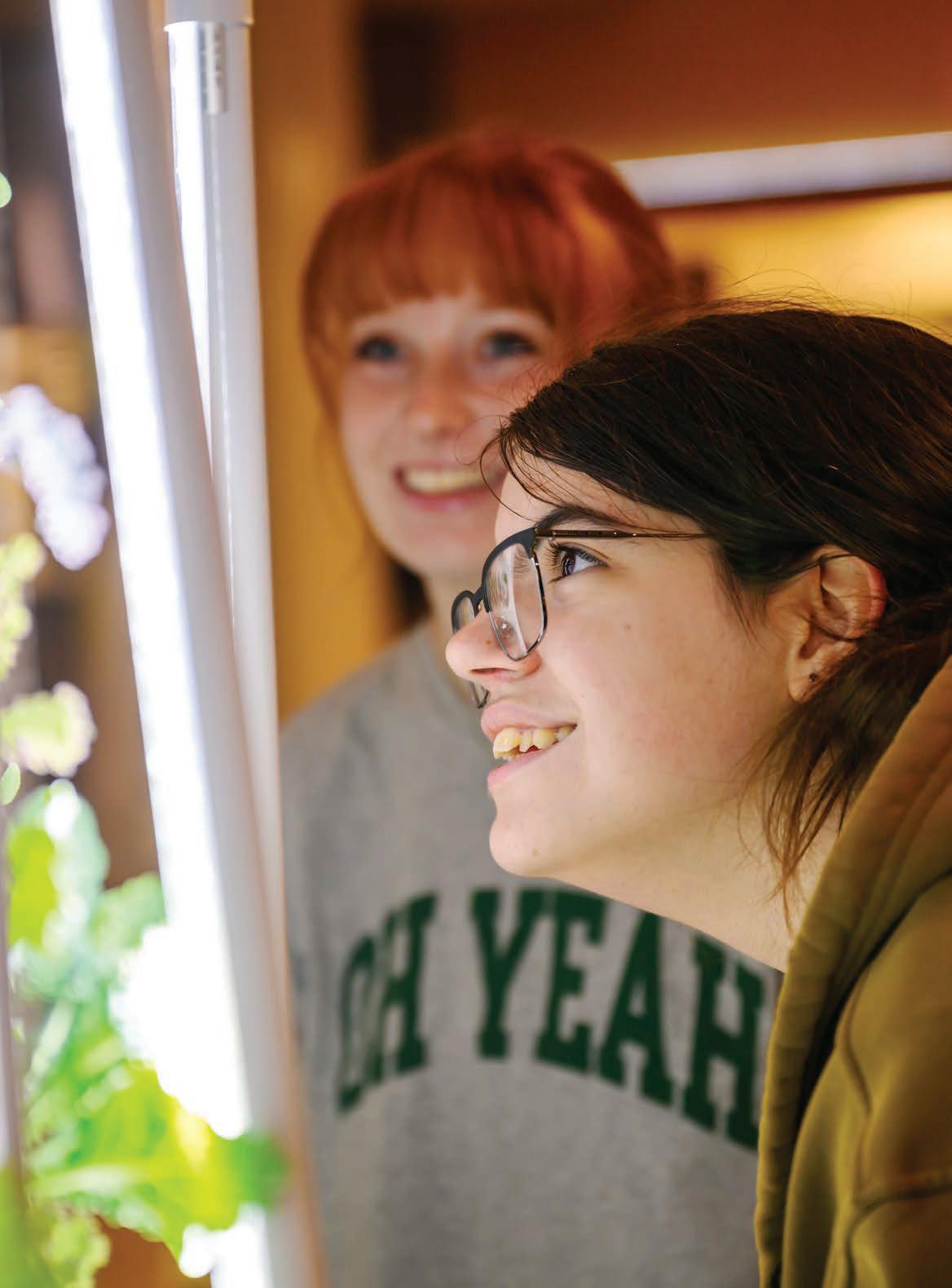
This year, WOUB celebrates its 75-year journey to becoming a trusted source of public media for Athens and beyond.
When OHIO’s Board of Trustees approved a request for a 10-watt FM station on campus, it was intended to operate on a non-commercial basis and serve as a place for college students to learn and grow. Seventy-five years later, those ideals are still shining through.
WOUB made its FM debut as WOUI in December 1949 after seven years as an unlicensed carrier current station. Ohio’s first college FM station—and only the third of its kind in the nation—has since grown into a thriving public media source serving 55 counties across three states on radio, television and the web.
“I like to say we’re a professional-supervised, studentpowered newsroom,” says editor-in-chief Atish Baidya. “It’s pretty amazing and wonderful that we’ve been part of the fabric of Southeast Ohio for 75 years.”
A number of the station’s professionals were once OHIO students, including director of radio Mark “Rusty” Smith, BSC ’78, MA ’85, and community engagement and membership manager Cheri Russo, BSJ ’96, MS ’07. The media entity also boasts notable alumni such as actor and former The Daily Show producer Brian Unger, BSC ’87, and Queer Eye creator
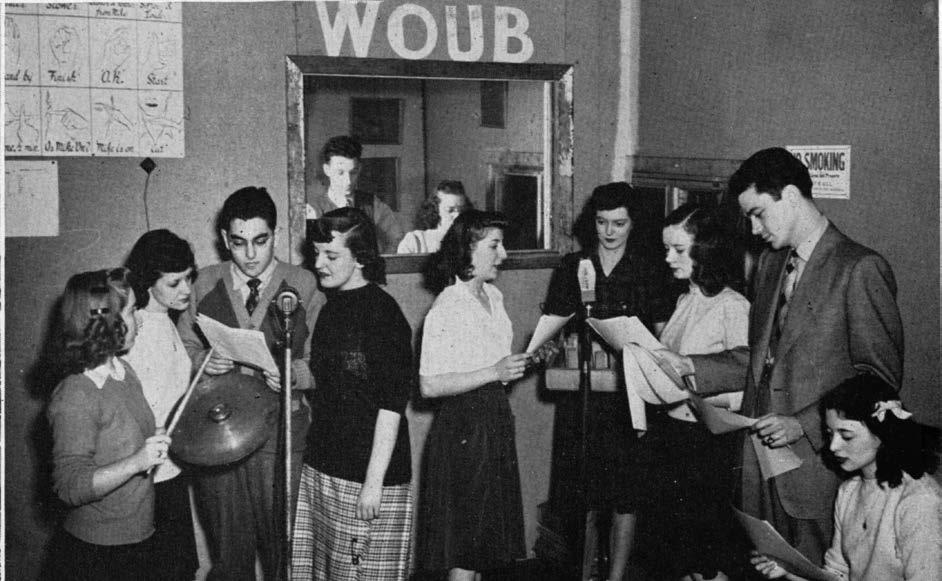
David Collins, BSC ’89, both of whom credit WOUB with helping them reach impressive career heights.
That level of affinity is common in “WOUB-ers,” who spend much of their free time inside the newsroom or shooting in the field for shows such as NewsWatch or Gridiron Glory. WOUB’s staff of more than 30 is supported by 150-plus student volunteers, many of whom get hands-on experience right from the start.
“Most colleges or universities require prerequisite classes or a certain amount of time before students can be hands-on,” says Russo. “What’s unique about WOUB is that students can walk in here on day one and hit the ground running. Start off as a volunteer to come work with us, and we’ll train you in the direction you want to go.”
Harshita Singhania, a junior studying journalism in the Honors Tutorial College, knows this firsthand—she wrote an on-air news story on her first day at WOUB.
Since then, Singhania has done everything from running the teleprompter to managing social media, building her confidence along the way. “I’ve grown so much as a person during my time at WOUB,” she says. “I wouldn’t trade it for the world.”
Along with being a media training ground for students, WOUB also fills a need for the region—an area spanning Ohio, West Virginia and Kentucky that Baidya and Russo refer to as a “news desert” of sorts.
“We don’t get a lot of media coverage in this area, and when we do, it’s not always for positive things,” Russo says. “WOUB works hard to serve this area with news and information people can use to make reliable quality decisions in their daily lives, and that’s something we hope to do for the next 75 years.” —Jen
Jones Donatelli, BSJ ’98
Visit ohio.edu/magazine to learn about the 25-season history of WOUB’s high school football program, Gridiron Glory

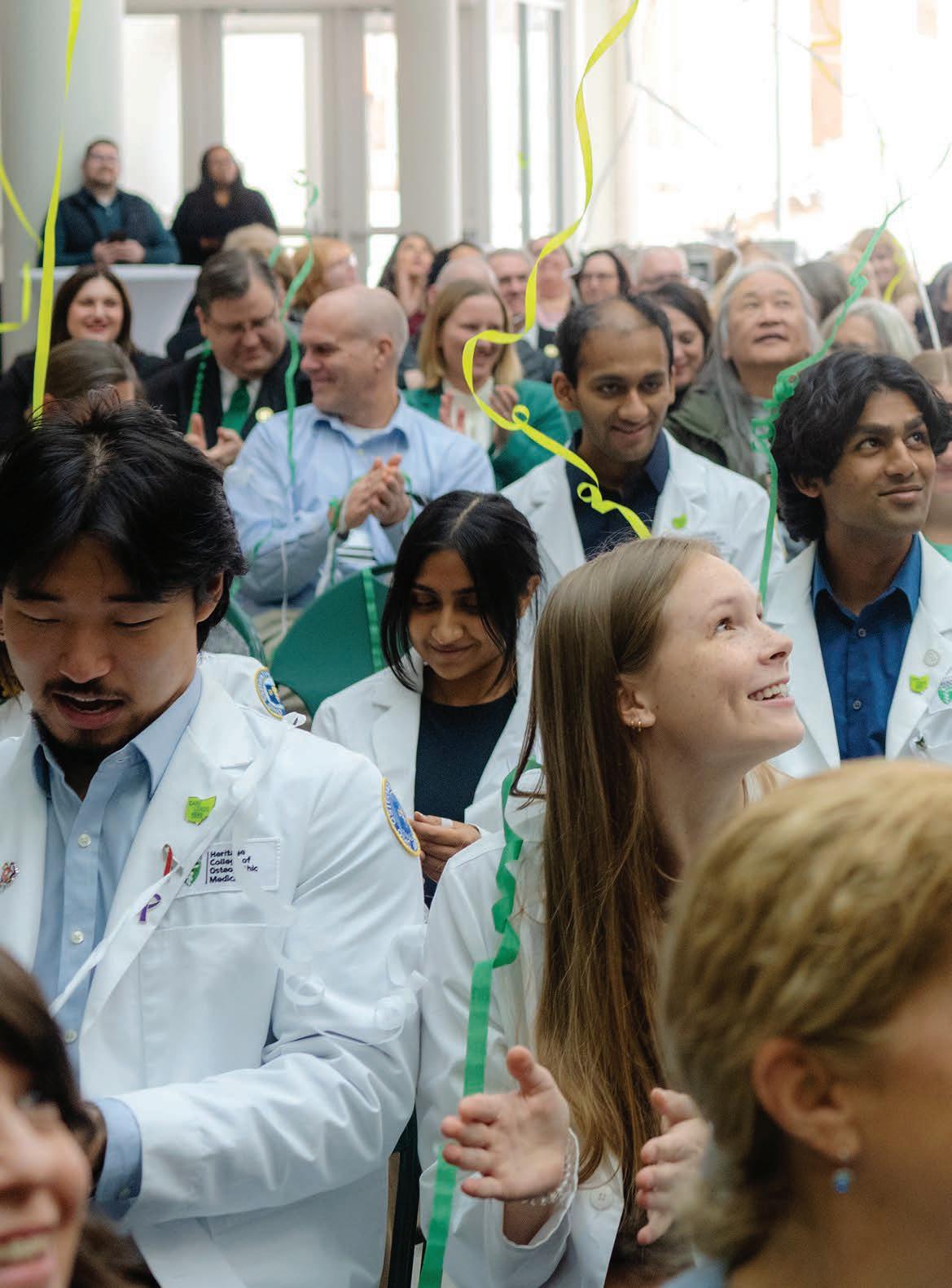
January saw a transformational, $70 million gift commitment from the Osteopathic Heritage Foundation to support scholarships and research in Heritage College of Osteopathic Medicine. Over the next decade, this gift will help provide annual scholarships that reduce the cost of in-state tuition and fees by at least 50% to 100 additional students—nearly doubling the number of students receiving significant scholarships. On the research side, $45 million of the total gift will support several endowed faculty positions, a Data Science Core that aligns expertise in health data management and analysis, state-of-the-art equipment at the Heritage Translational Research Center (currently under construction), and a new institute focused on healthy aging that will bring together key research assets at the University to form an internationally recognized aging research hub. Learn more about this gift and the initiatives it will support, including Heritage College’s Vision 2035 10-year plan, at ohio.edu/foundation-gift
RICH-JOSEPH FACUN, BSVC ’01
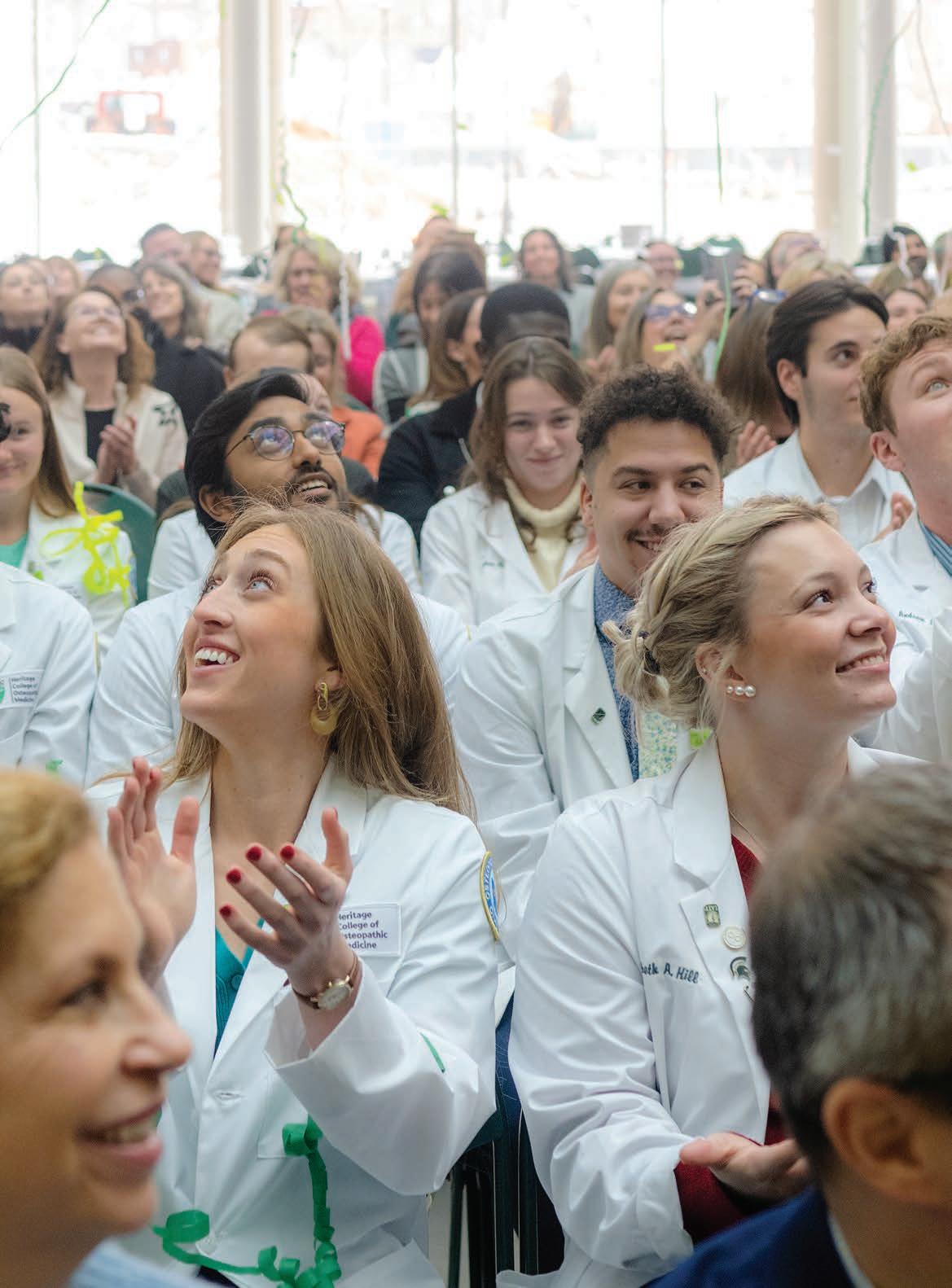
When Shrinidhi Vaideeswaran arrived on campus as a first-year student in 2022, she mostly socialized online, meeting high school friends in virtual gaming environments like “Valorant” or “Minecraft.”
“I had to build a friend group from scratch—but I hate small talk,” says the now-junior double majoring in international business and business analytics. “I’d rather just hop on a game.”
Then she heard about the new OHIO Esports Arena in Scripps Hall.
“The first day I came in, they asked if I wanted to stay and help broadcast the varsity Twitch stream,” Vaideeswaran recalls. Before long, she ran both a broadcast camera and OHIO Esports’ social media. She soon moved up the ranks from club treasurer to vice president to president.

Vaideeswaran, president of
competes
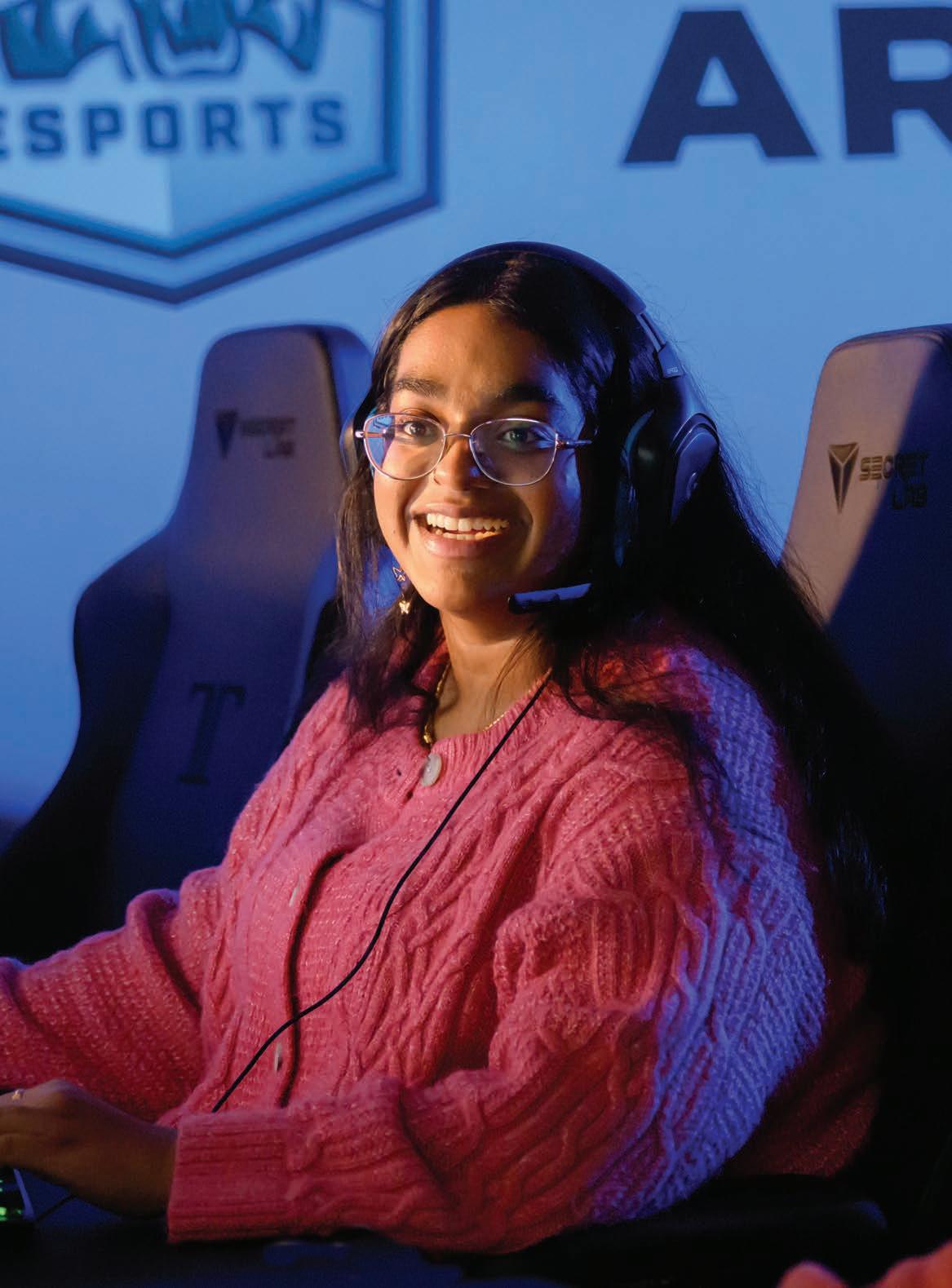
[THIS PAGE AND OPPOSITE] The Bobcat Esports team offers a supportive community for players, networking opportunities with alumni, and educational experiences in areas like broadcasting and event management.

“Shrinidhi’s now my second-in-command,” says OHIO Esports Director Jeff Kuhn, MA ’11, PHD ’17, “because she found her people.”
OHIO Esports offers a high-end gaming lounge and a competitive ecosystem ranging from casual groups to the 40-member varsity team competing in the MidAmerican Conference (MAC). But for Kuhn, and many of the club’s 800-plus members, it goes far beyond competition and entertainment.
At least 85% of U.S. teens report playing video games, according to a 2024 Pew Research Center report. Gaming has far outpaced movies and music to become the world’s largest entertainment industry. The gaming market is estimated to approach $350 billion in 2025 according to The Business Research Co.’s Gaming Global Market Report.
“That means jobs,” Kuhn says, and not just for programmers and engineers, but also for artists and academics.
Through Scripps College of Communication, Ohio University has been at the forefront of the shifting multimedia industry, including the growth of gaming, to prepare students for careers in an evolving field.
In 2005, Ohio University opened its Game, Research and Immersive Design (GRID) Lab to provide students with space and equipment to gain experience in virtual reality and 360-degree video technology. In 2019, Scripps College combined the GRID Lab and its work with its School of Information and Telecommunication Systems to launch the J. Warren McClure School of Emerging Communication Technologies.
The following year, the McClure School partnered with OHIO’s College of Business to launch an undergraduate esports certificate that combines gaming technology expertise with the University’s excellence in sports administration. The certificate offers three track options: sport management, game design and information technology. Adding it to an existing major prepares students for jobs in a variety of fields, including supporting the dozens of global esports tournaments held annually, with prize pools topping out at $60 million for the Esports World Cup. And in 2021, Scripps College added an undergraduate major in virtual reality and game development, also through the McClure School.
“As media has changed and technology has changed, our college has worked hard to not only keep pace with but to stay ahead of those changes,” says Scripps College Dean Scott Titsworth. “We’re applying our decades of excellence in training award-winning
storytellers to all the ways that stories are told today. That includes virtual reality and gaming.”
Titsworth notes that the OHIO Esports Arena is far more than a recreational space. It also serves as a facility for experiential learning and a test lab for students interested in careers in game development or the competitive side of gaming.
This spring marks four years since the OHIO Esports Arena first opened—and the extracurricular program has grown from its original 12 members to more than 1,000 students and alumni. OUCU Financial recently became the club’s first multiyear sponsor; its commitment through June 2027 marks a new era of growth and support for Bobcat Esports.
Kuhn originally pitched the idea of an esports program in 2017 as a doctoral student working in the Office of Instructional Innovation and the GRID Lab.

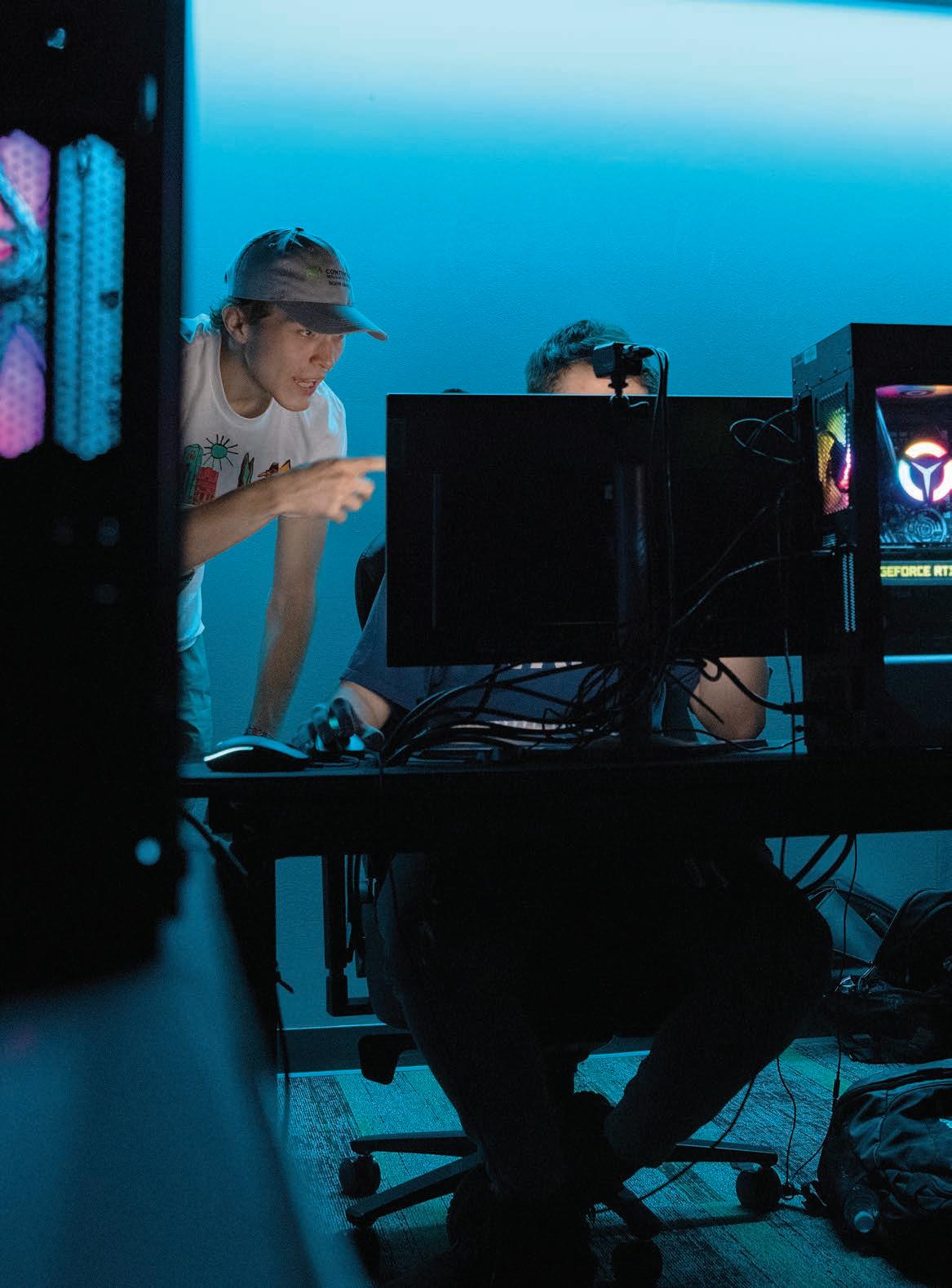

“We had this fantastic game development program, but no place to just play,” he says. “There were spaces on campus for music, books, film, theater—but nothing for games.”
The space was vital not only for its social component, but for the career development opportunities it could offer as well.
“Anyone can gain a professional advantage from gaming,” Kuhn adds, regardless of whether they’re interested in the gaming industry as a career. “Our competitors spend hours critically analyzing their opponents’ videos, honing complex strategies and problem-solving as teams.”
The OHIO Esports Arena’s collaborative culture attracts an increasingly diverse pool of campus gamers. Women now comprise at least 25% of OHIO’s varsity team and more than 40% of its club teams, largely driven by a club of self-proclaimed “Gamer Gals.”
The positive impact of OHIO Esports ripples out through community outreach events: On April 5 and 6, OHIO will host regional playoffs for the Esports Ohio league, drawing 200 high school gamers from across the state.
Best of all, OHIO Esports students gain friends and connections for life. “Normally, you’re in a campus club, you graduate, and you lose touch,” says Kuhn. “But with esports, alumni stay involved.”
Vaideeswaran currently counts 300-plus alumni active on the OHIO Esports Discord server. “They watch our streams and come to tournaments,” she says. “It is actually a great networking resource for postgraduation.”
Until then, Vaideeswaran sees friendly faces from the OHIO Esports Arena everywhere on campus. “We definitely break social and professional barriers,” she says, “and that’s only going to grow.” —Anita Martin, BSJ ’06
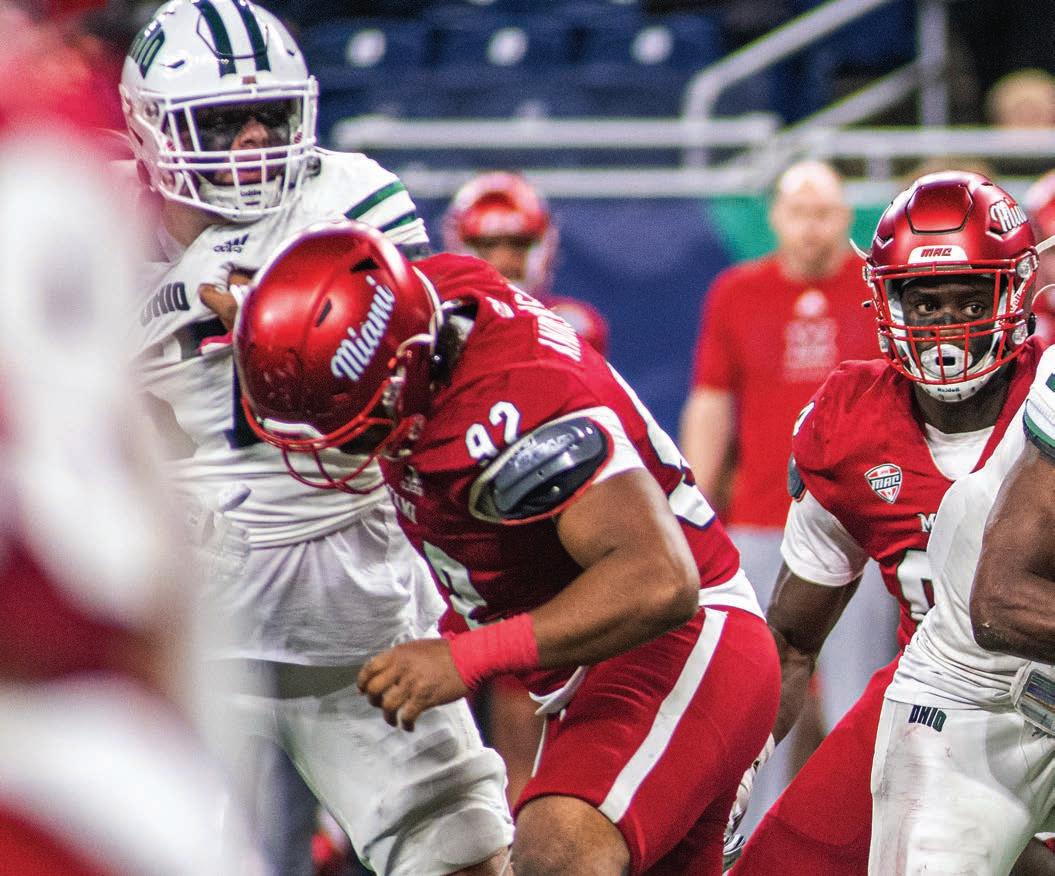
Bobcats make the news—and the OHIO community proud—every day. Read about a few of the Ohio University alumni, students, faculty and staff who have made headlines in recent months.
ONE FOR THE HISTORY BOOKS | The Bobcats set a number of Mid-American Conference (MAC) records at the end of a wildly successful 2024 season. The superlatives began on Dec. 7, when OHIO won its first MAC football championship in more than 50 years, defeating rival and 2023 MAC Champion Miami University. It was the first MAC Championship game in which a team was held to no touchdowns, and the final score of 38-3 represents the largest margin of victory in MAC Championship history. The season became the Bobcats’ third consecutive with 10 wins and the first ever with 11 wins, thanks to a Dec. 20 triumph over Jacksonville State at the StaffDNA Cure Bowl—which made OHIO the first MAC program ever to win six consecutive bowl games. It was the first win under new head coach Brian Smith.
BEST OF THE BUNCH | Faculty members from OHIO’s Institute to Advance Health Equity (ADVANCE) represent three of the four authors behind the Journal of Rural Health’s Article of the Year for 2024. ADVANCE researchers Bethany Lemont, Berkeley Franz and Cory Cronin, BSH ’04, partnered with Neeraj Puro of Florida Atlantic University to publish “Efforts by critical access hospitals to increase health equity through greater engagement with social determinants of health,” which was published in the journal in June 2023. The study examines how hospitals screen patients for social needs, with an emphasis on how critical access hospitals—those in rural settings that meet certain criteria for size and population served—play a vital role in connecting communities to resources that address unmet social needs.
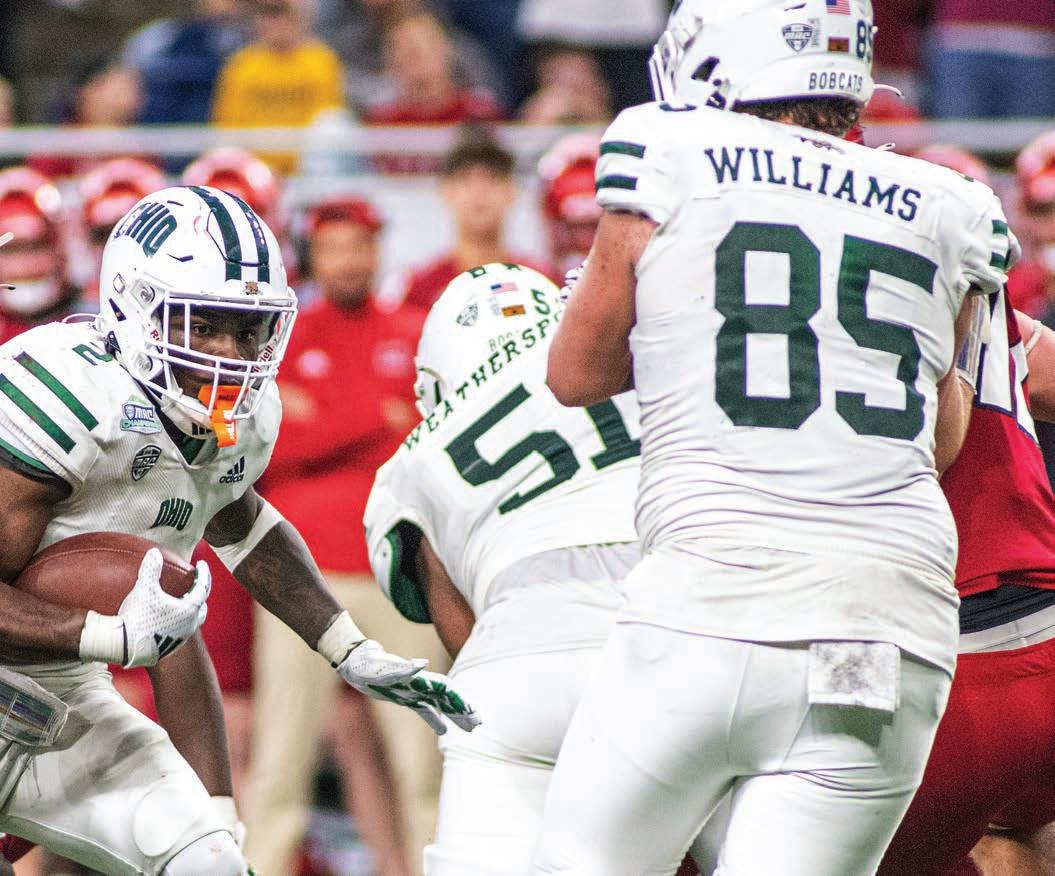
FUNDING FOR THE FUTURE | OHIO programs received significant investment in recent months. Last year, Heritage College of Osteopathic Medicine received more National Institutes of Health funding than any other osteopathic medical school in the country, and in January it saw a transformational commitment from the Osteopathic Heritage Foundation (see page 10). Meanwhile, the Russ College of Engineering and Technology and an interdisciplinary University project focused on workforce development each received grants of more than $2 million. Russ’ grant from the Ohio Department of Development will support advanced coal technology research. The interdisciplinary project—Optimizing Navigation for Rural Advanced Manufacturing Pathways— comprises four OHIO colleges and two regional campuses; it received federal funding to support regional STEM education.
FOUR FOR FOUR | Each year, universities can nominate up to four students in the national Goldwater Scholarship competition, the country’s premier undergraduate scholarship in mathematics, engineering and the natural sciences. For the first time since the program’s inception in 2006, all four of OHIO’s nominated students were among the 438 winning scholars nationwide. As if that weren’t enough, the four Bobcat winners represent the highest total received at any Ohio university for the 2024-25 academic year. OHIO’s Goldwater Scholars this year are seniors Greta Hibbard (engineering physics, Honors Tutorial College), Brady Phelps (advanced computing, Honors Tutorial College), Jayanna Smith (biological sciences, College of Arts and Sciences) and Benjamin Stiadle (applied math and cellular and molecular biology, College of Arts and Sciences).
Two of the University’s newest hires are partnering to lift OHIO’s national profile as a leading research institution.
On July 1, 2024, Ohio University welcomed two new leaders: Executive Vice President and Provost Donald Leo and Vice President for Research and Creative Activity Eric Muth. Few positions, save the University President, have more potential for impact on an institution’s academic reputation or its research trajectory than these two key hires. Leo and Muth’s partnership and collective vision will set the course for OHIO’s research direction in the years to come.
“Having long served as a university provost, I knew there was a truly rare opportunity to fill these two key positions at the same time,” says President Lori Stewart Gonzalez. “In the searches I was looking for three things: leaders with the experience and confidence to act boldly, individuals who share my commitment to public higher education and the impact it has on our students and our state, and two people who simply liked each other. I couldn’t be happier that we found all of that in Don and Eric.”
As Leo and Muth stepped into their roles, Gonzalez handed both big assignments. Leo would lead the implementation of the University’s Dynamic Strategy, freshly approved by the OHIO Board of Trustees in June 2024. Meanwhile, Muth would take ownership of the strategy’s “Discover” pillar, demonstrating quick and significant growth in research expenditures
in order to further solidify the University’s recently reaffirmed status as an “R1” or “very high research” university by the Carnegie Classification of Institutions of Higher Education.
Both arrived at OHIO with resumes that proved their ability to take on challenges. Leo spent the previous decade serving as the inaugural dean of the University of Georgia’s College of Engineering.
“When I told colleagues I was leaving Virginia Tech to be the first engineering dean at UGA, people tried to talk me out of it,” Leo says. “Georgia Tech already had a large, established, top-ranked college of engineering an hour down the road, and no one thought we’d be able to compete with that.”
Leo led UGA’s College of Engineering to enroll more than 2,000 students; this year, mechanical engineering and computer science were among the top 10 declared majors for new UGA students.
For his part, Muth most recently served as the vice president for research at North Carolina A&T after teaching and researching at Clemson University for nearly 20 years. From 2020 to 2023, Muth helped N.C. A&T increase research expenditures by 46%, bringing it within reach of R1 status. (The university ultimately fell short based on number of research doctorates awarded.)
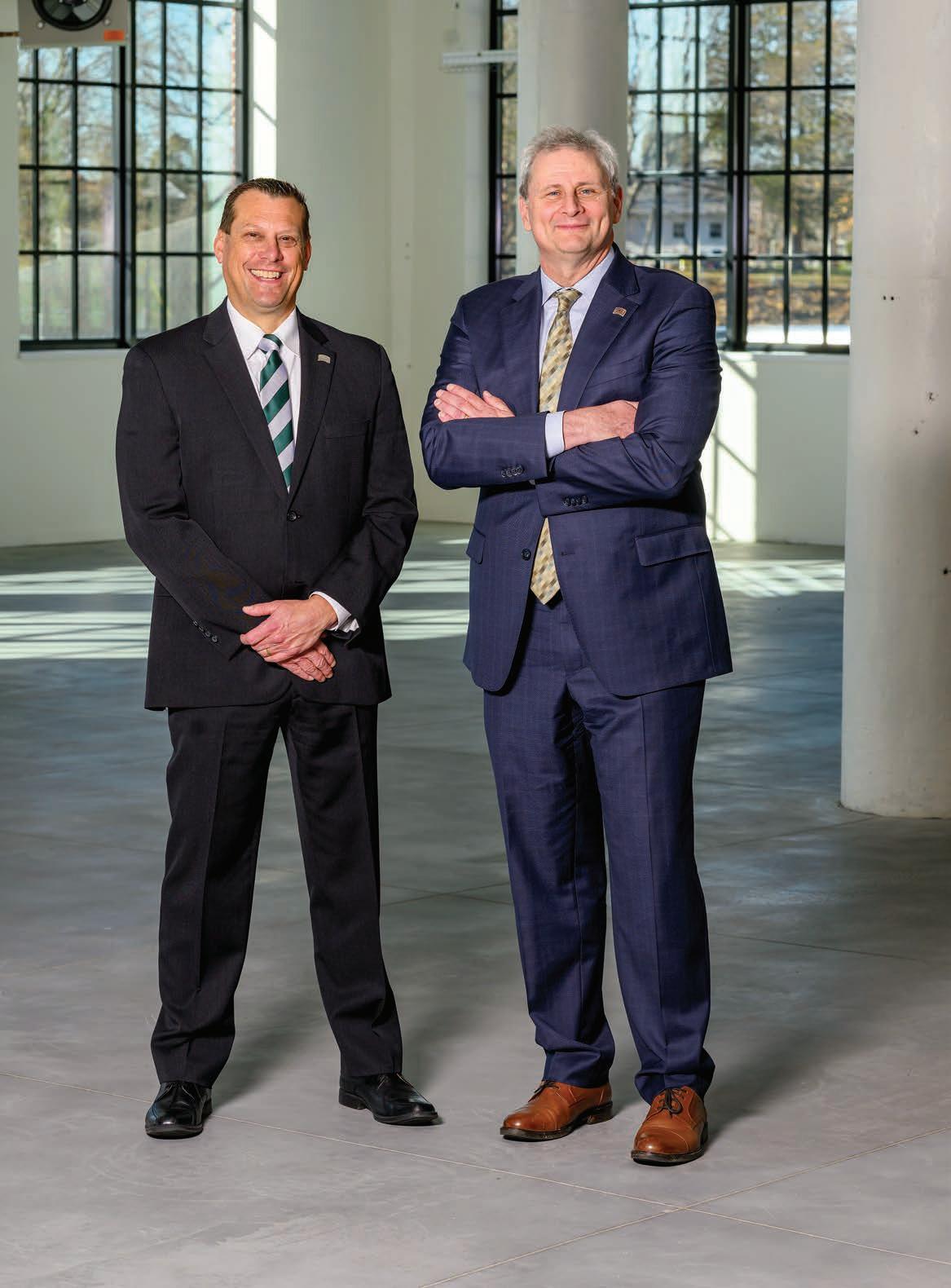
Vice President for Research and Creative Activity Eric Muth (left) and Executive Vice President and Provost Don Leo (right) in the Russ Research Opportunity Center, which celebrates its grand opening this spring. Like the RROC, OHIO’s leadership is poised for expansion and excellence in research and education.
BY BEN WIRTZ SIEGEL,
It’s not “either/or;” it’s “both/and”
One of the early signs that Muth and Leo were right for their respective roles was their mutual belief that research and teaching are not two separate endeavors, but rather a collaborative pursuit. It seems like a simple ideology, but at some research institutions, the two are treated as distinct and separate missions.
“What attracted me to OHIO was the narrative about being a T1/R1 university,” Muth says, referring to Goal No. 1 of OHIO’s recently inked Dynamic Strategy, which calls for the University to achieve and retain the nation’s highest standard in both teaching and research.
In research, that means maintaining the institution’s R1 status. Oddly enough, there is no equivalent classification for teaching excellence, but OHIO
intends to change that with help from the John N. Gardner Institute for Excellence in Undergraduate Education and peer institutions. The idea is to define, and then attain, “T1” status, solidifying the University as a thought leader in teaching excellence.
Muth says the access students have to seasoned faculty mentors and to best-in-class research at OHIO is rare for a national institution of this size.
“We have the ability to provide high-quality, closeknit teaching and mentoring relationships with our students, as well as access to state-of-the-art research labs, experiential learning and other handson educational opportunities, right here in our community,” Muth says. “If a first-generation student— like I was—wants to become an astrophysicist or
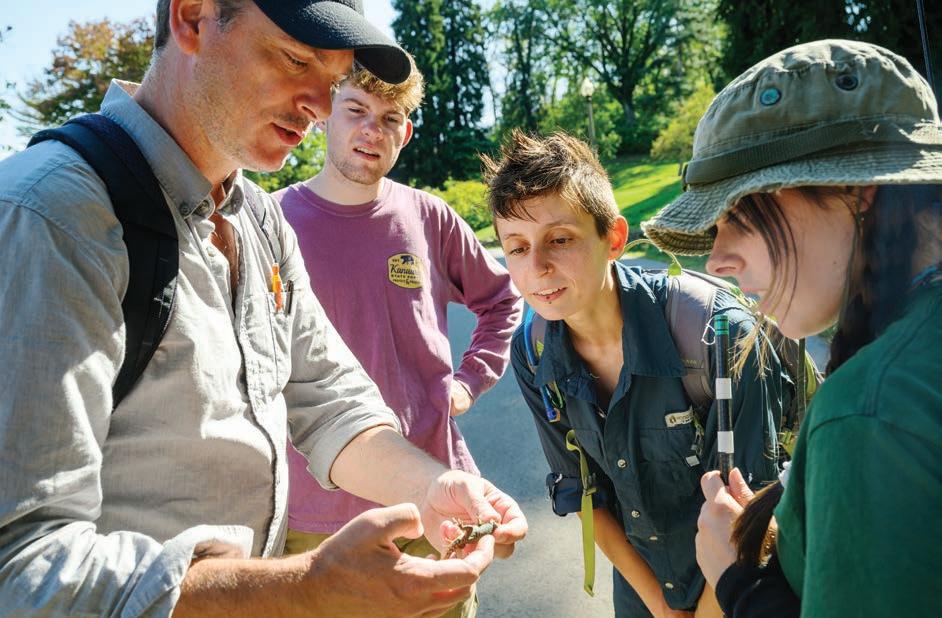
of research and innovation
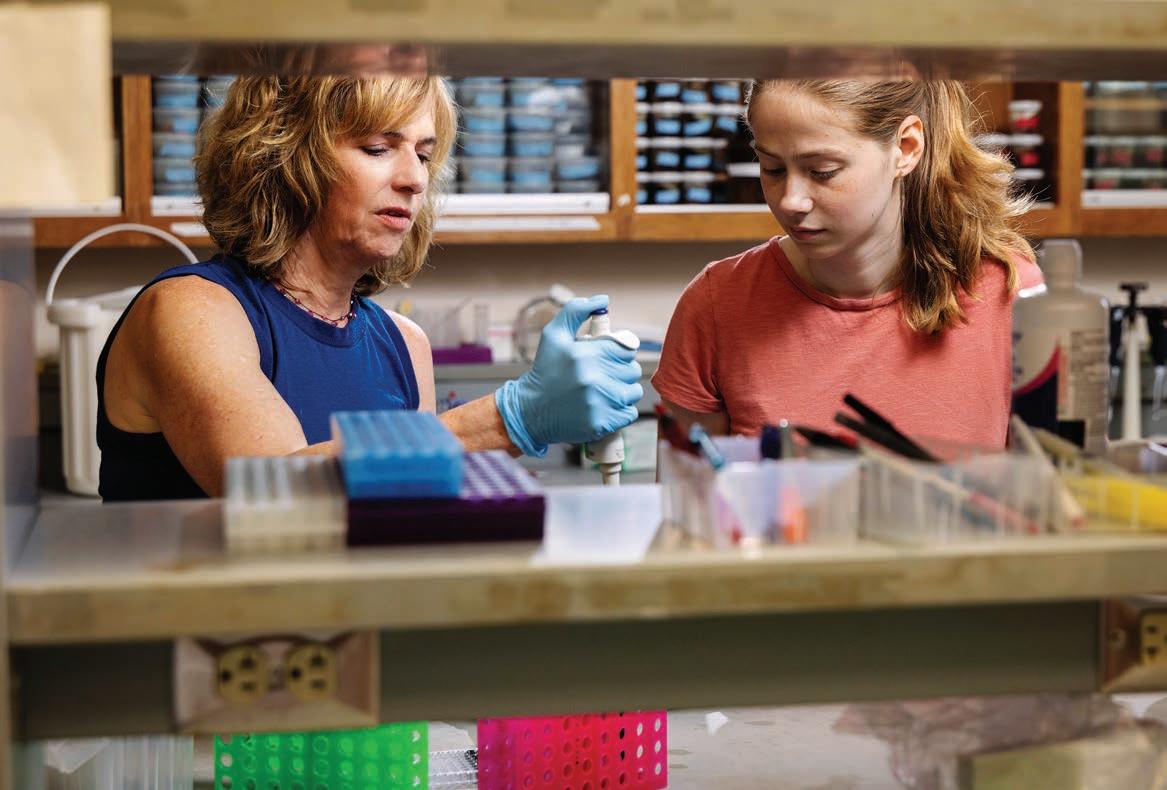
perform in a symphony orchestra or make a name for themself in Hollywood, and they have the talent, we have the resources to help them achieve that goal.”
Leo, who was also a first-generation college student, adds that OHIO gives students the opportunity to put their classwork and research into practice in ways that serve communities in the region and around the world. As part of his work leading the implementation of the Dynamic Strategy, Leo advocated for expanded scholarship funding for experiential learning, community research, internships and externships. In October, the University announced added investment of $500,000 to help fund the OHIO Experience Awards, OHIO Discover Awards and OHIO Explore Awards. (Learn more at ohio.edu/experience.)
“Our hope is that all students who want to engage in experiential learning—whether that be community engagement, research or creative endeavors, internships, study abroad/away or other activities—
will have the opportunity,” Leo says. “It goes back to the commitment we make in our OHIO Mission: We are holding the door open to an education that will give our students the knowledge and skills they need to make an impact beyond our campuses.”
In terms of research that impacts communities, Leo and Muth point to examples like the collaboration between professors John Sabraw in Chaddock + Morrow College of Fine Arts and Guy Riefler in Russ College of Engineering and Technology, whose research helped launch a local company that turns acid mine drainage into paint. Or plans to shift OHIO’s Edison Biotechnology Institute to focus on healthy aging in ways that will benefit the state’s aging population. Or Heritage College of Osteopathic Medicine’s (HCOM) recent receipt of an $8 million grant from the National Institutes of Health (NIH) to fund a portion of its new Heritage Translational Research Center, which will serve as home to applied research in fields such as healthy aging and diabetes.
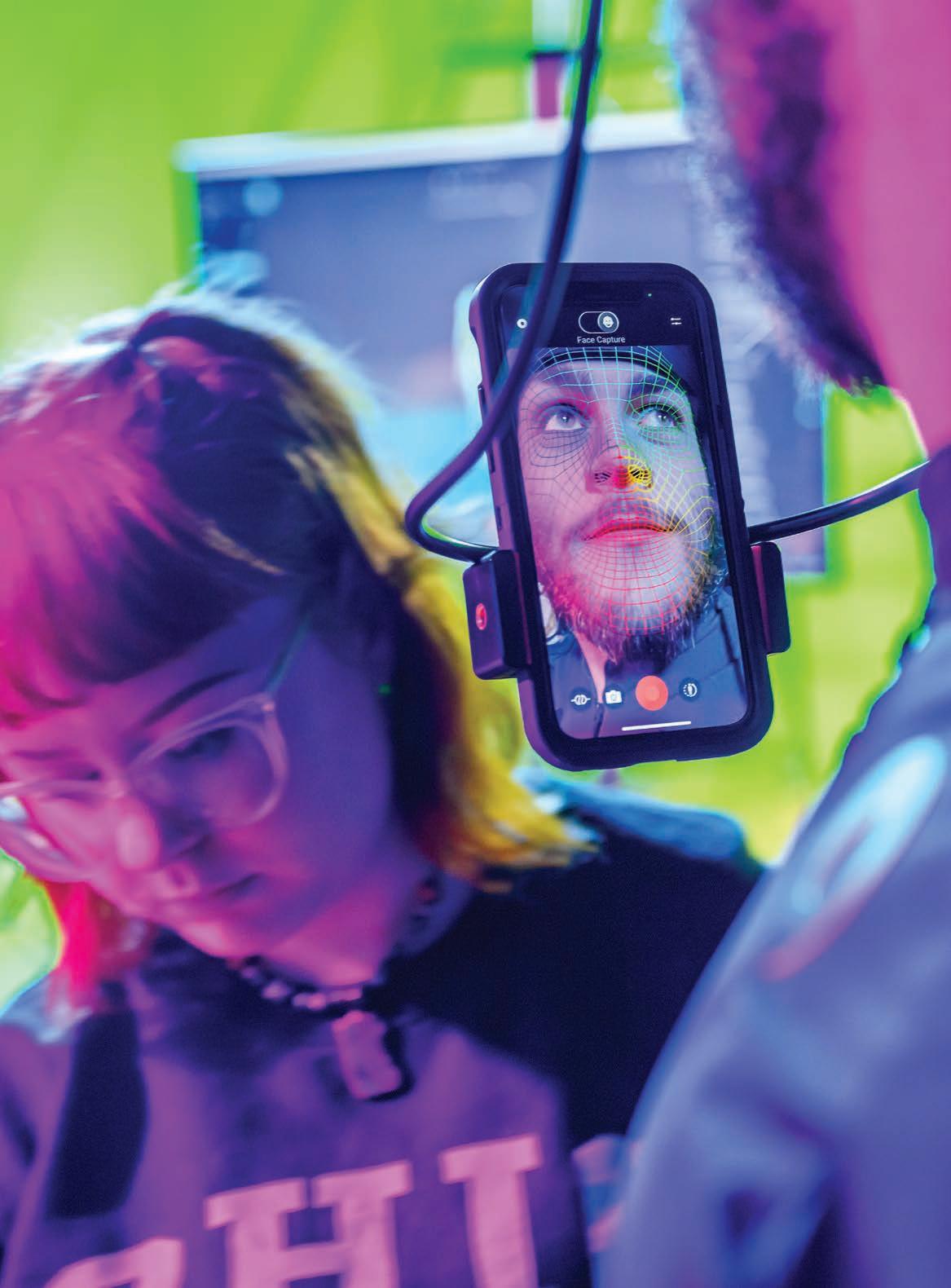
“We have the ability to provide high-quality, closeknit teaching and mentoring relationships with our students, as well as access to state-of-the-art research labs, experiential learning and other hands-on educational opportunities, right here in our community.”
—EXECUTIVE VICE PRESIDENT & PROVOST DON LEO
“We recognize that the faculty are the heartbeat of the University,” Leo says. “They drive curricular innovation, elevate our research capabilities and ultimately inspire student success and community impact.”
Muth says the new hires will support the research focus areas outlined in the Dynamic Strategy— healthy aging, energy and the environment, as well as artificial intelligence—and will foster collaborative research while reinvigorating historic areas of strength for the University.
“We are seeing more and more funding opportunities for research that extends across disciplines,” Muth says. “The world’s biggest problems require experts from multiple disciplines working together to build solutions.”
“If we’re doing it right, we’re not just doing research for publications and research for grants,” says Darlene Berryman, associate dean of research and innovation at HCOM and the lead on the NIH grant proposal. “We are making a difference in communities and making a difference in the lives of people.”
Berryman also served on the committee that hired Muth as vice president of research—a role that had previously been a co-title for the Graduate College dean, as is common at regional institutions but not at national, R1 public universities like OHIO. Berryman is excited to see how the future will unfold under Muth’s leadership. “Researchers and those who are teaching, they feel like the change is coming,” Berryman says. “They feel it.”
Leo and Muth sent a clear signal in October, when Gonzalez announced that she had approved the duo’s proposal to invest $1.5 million in recurring funding to support up to 15 new tenure-track faculty—in disciplines ranging from dance, visual communication, marketing and psychology to natural sciences and engineering—to support the Dynamic Strategy.
Muth, whose title isn’t limited to “vice president of research” but also includes “and creative activity,” goes on to say that he and Leo also expect to approve faculty lines that bring together creative scholarship and scientific research, similar to the pollution-to-paint collaboration. “I don’t see the research and the creative activity as two different things,” Muth says.
Leo emphasizes that while the new faculty investments will help broaden the University’s research portfolio, OHIO will continue to focus on recruiting and retaining faculty who are passionate about teaching and mentoring students, both in the classroom and in the lab. He says leaning into the University’s historic strength in teaching and student success while growing the research portfolio will ultimately elevate OHIO’s profile nationally.
“The future of Ohio University isn’t about just academic excellence or just exciting discoveries through applied research,” Leo says. “It’s a joint effort that doesn’t compromise in either area, and it’s what will make us a leader in serving not only our local and regional populations, but the nation as a whole.”
—Robin Oliver, vice president for University Communications and Marketing
OHIO’s new professional development program positions today’s alumni to become tomorrow’s leaders.
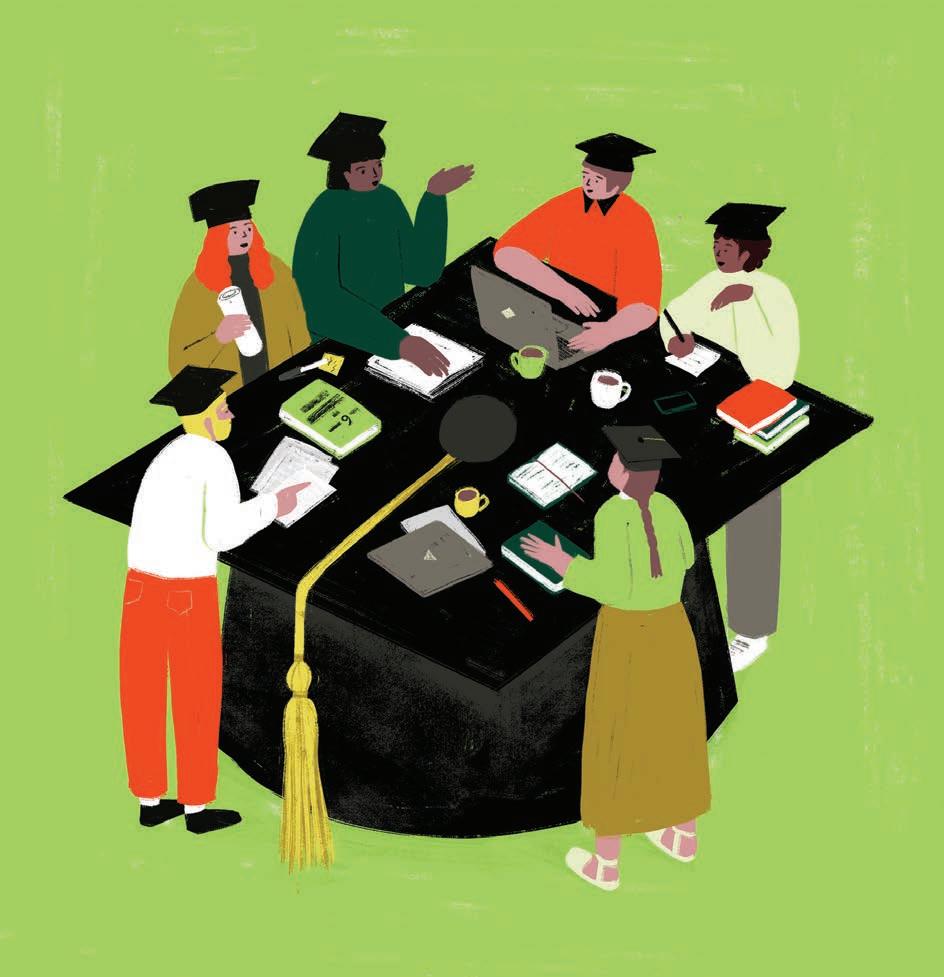
at ohio.edu/YAL
Are you an OHIO graduate under age 35? Are you looking to reconnect with the University? Are you interested in volunteering? If you answered yes to these questions, you may be a candidate for the Ohio University Alumni Association’s Young Alumni Leaders (YAL) Program.
Now in its second year, YAL gathers about 30 recent graduates for monthly in-person and virtual meetings. Through hands-on volunteer projects and professional development discussions, YAL participants cultivate skills that can be applied to volunteer opportunities with OHIO, as well as in their personal and professional lives.
“This isn’t for someone looking for just another leadership program,” says Dana Wright, senior associate director of student and early engagement in the Office of Alumni Relations. “It’s a way for passionate Bobcats who have been away from OHIO for a few years to find a really intentional way to reconnect and reach back to the place that meant so much to them.”
Wright and Laurie Lach, assistant vice president of alumni relations and campus partnerships, created YAL to fill a long-standing gap in OHIO’s alumni outreach: Today’s volunteers tend to be professionals further along in their careers. While their contributions are incredibly important, Lach says, the Office of Alumni Relations was missing a “thoughtful way to engage alumni during that transition time from student to young professional.”
Based on the experiences of the inaugural YAL cohort, which wrapped up in April 2024, there is a mighty appetite. Sam Glaser, BBA ’20, found that the program allowed him to reconcile “the lack of closure” he felt after his senior year was cut short by COVID-19. While Glaser had previously taken part in various College of Business alumni programs, YAL was an opportunity to receive “more holistic and effective” guidance about becoming a productive volunteer.
The curriculum centered on “The 6 Types of Working Genius,” by bestselling author Patrick Lencioni, which posits that every person brings a specific kind of “genius,” or area in which they excel, to a given project. Glaser says the book and virtual discussions about it challenged him and fellow participants to “narrow in on what made us each passionate about OU” and identify the areas where they could make the biggest impact.
This idea of intentional volunteerism is what resonated most with Imani Edwards, BSS ’19, who also appreciated the program’s goal of cultivating the next generation of alumni volunteers.
“We are young, but we have very unique experiences,” which can help the University better serve current students and connect with younger alumni, says Edwards. “I want to be part of the progress.”
About halfway through the seven-month program, YAL participants were divided into small groups to put their newfound leadership skills into action, meeting with deans of individual colleges to offer suggestions on various challenges related to volunteerism or young alumni engagement.
Based on the enthusiasm the first cohort brought to these engagement projects, Wright says the 2024-25 cohort began their projects earlier in the program. That group “wanted to dive in immediately. They were doers,” she notes. The second cohort began in September 2024 and ran through March 2025.
Applications for the 2025-26 cohort are open from late spring into summer, and Edwards says she wouldn’t hesitate to recommend the program.
“YAL taught me to find strength in the power [of] where I am in life,” she says. — Cat Hofacker, BSJ ’18; Taylor Connelly, BSJ ’26, contributed to this story
Some scientific breakthroughs are so profound that they change human knowledge and technology as we know it: Ernest Rutherford’s atomic model in 1911, Alexander Fleming’s discovery of penicillin in 1928, Vera Rubin’s observation of dark matter in 1978. In 2023, Saw Wai Hla, a professor in the College of Arts and Science’s Department of Physics and Astronomy and scientist at Argonne National Laboratory, joined the ranks of such noteworthy scientists. His achievement? The ability to detect a single atom via X-ray.
This remarkable feat—an effort more than 12 years in the making— is both a triumph of cutting-edge technology and a glimpse into a future where understanding the atomic scale could revolutionize industries, enhance scientific accuracy and change lives in ways we cannot yet imagine.
Hla and his team of physicists and chemists, including Ph.D. candidates at OHIO, first published their extraordinary findings in the scientific journal Nature in 2023. Since then, news of their success has rippled through the scientific community worldwide, placing Ohio University front and center in headlines about humanity’s capacity for innovation.
“We can now detect exactly the type of a particular atom, one atom at a time, and can simultaneously measure its chemical state,” explains Hla, who is also the director of the Nanoscale and Quantum Phenomena Institute at Ohio University. “This discovery will transform the world.”
The potential impact of this transformative advancement on the field of medicine—including diagnoses, personalized treatment and new drug development—is difficult to overstate.
Imagine if cancer could be detected at its earliest, most treatable stage, not through invasive biopsies but

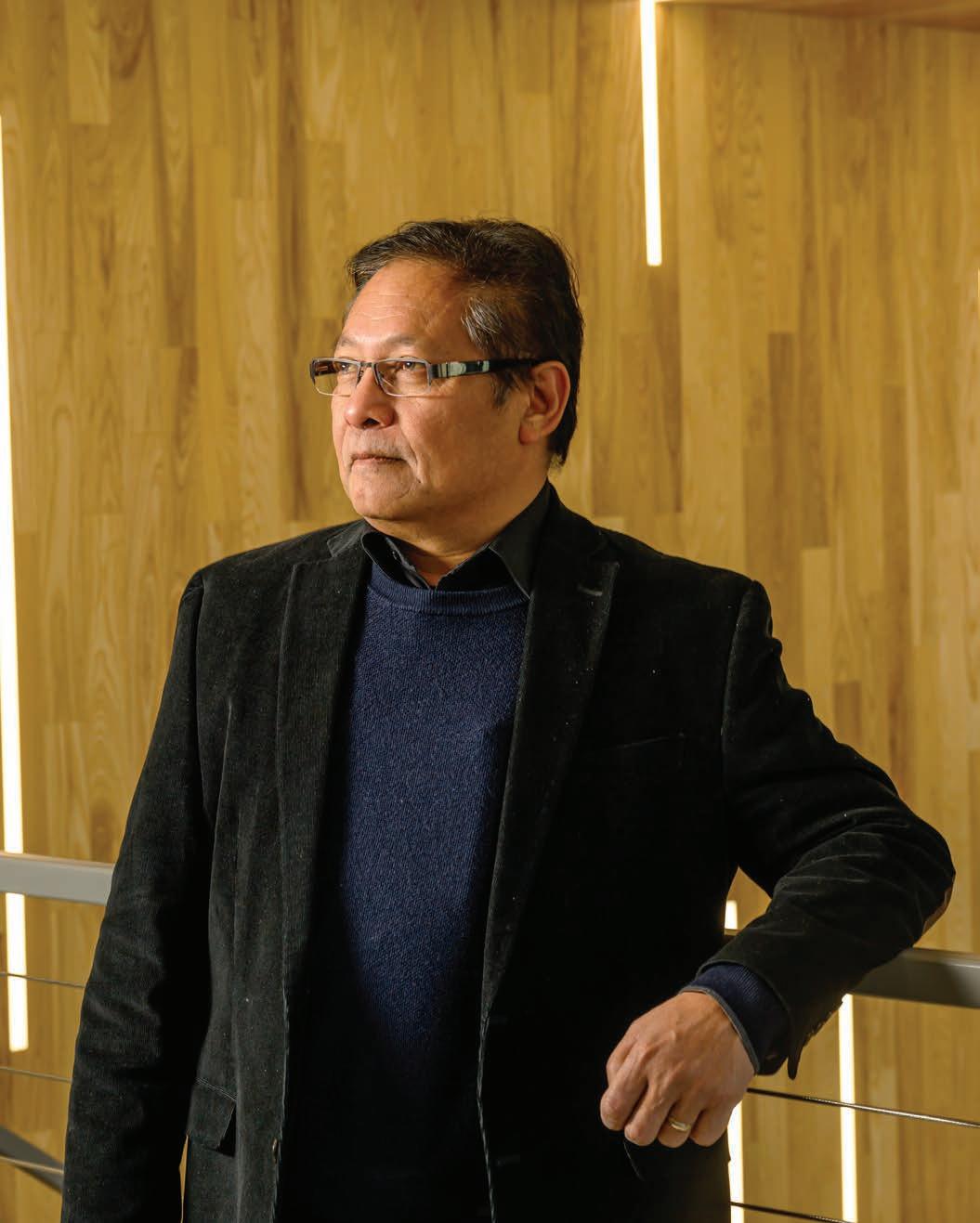
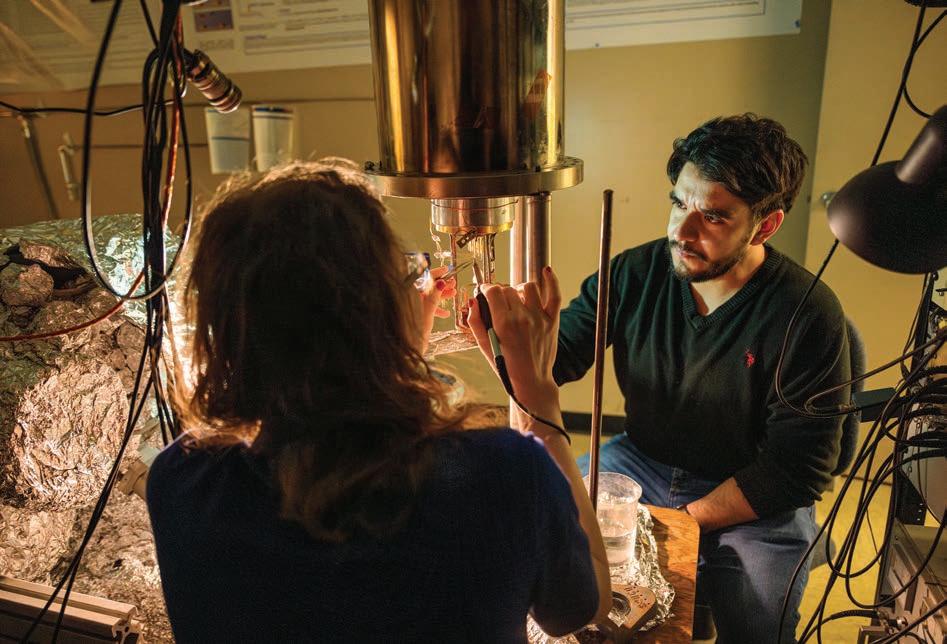
examining a small sample of a patient’s cells, one atom at a time. Current medical imaging techniques like CT scans and MRIs, though invaluable, are not capable of providing the resolution needed to observe sample tissue at the atomic level. New technologies developed from Hla’s innovation could lead to diagnostic and monitoring tools that are faster, more accurate and more accessible to patients across the globe.
This breakthrough could lead to a new era in pharmaceutical development as well. With an atomiclevel understanding of how molecules interact, Hla explains, pharmaceutical researchers could develop drugs that are more effective at targeting disease, with fewer side effects.
A similarly granular approach can be imagined for the surging trend of personalized medicine. With the tools to peer behind a patient’s symptoms at the building blocks of health issues, a doctor could prescribe medications and therapies customized to an individual’s molecular makeup.
Detecting a single atom via X-ray imaging holds immense potential for a variety of fields beyond medicine. The ability to observe and understand atomic structures in unprecedented detail could lead to the creation of next-generation materials with properties we can’t yet fully imagine. For instance, the design of stronger, more lightweight materials could fuel revolutionary advancements in industries like aerospace, construction and electronics.
According to Hla, many rare-earth materials are used in everyday devices, such as cell phones and computers, and are extremely important in creating and advancing technology. Because his discovery enables scientists to identify both an element’s type and its chemical state, they will be able to better manipulate the atoms that make up different materials to meet ever-changing needs in various fields.
As if that weren’t enough, Hla and his team have also developed a new method of interpreting data about electrons in a molecule, which can have enormous
impact in the field of quantum physics. This new avenue for studying the behavior of matter at the most fundamental level will provide deeper insight into everything from superconductivity—a vital component of research for high-speed trains and computer chips alike—to the mysteries of dark matter, offering fresh perspectives on some of science’s most enduring questions.
“Scale is very important in science, as it allows for comparative analysis from macro to nano levels,” says Eric Muth, the University’s new vice president for research and creative activity. “Dr. Hla’s discovery puts a new tool in the science toolbox to utilize X-rays to study scale at the single atom level, opening the door to new applications and discovery.”
Since German physicist Wilhelm Roentgen discovered the X-ray in 1895, X-ray imaging has been commonplace. It’s used in everything from medical examinations to security screenings in airports. Even Curiosity, NASA’s Mars rover, has used an X-ray device to learn that the material composition of rocks on Mars is surprisingly similar to volcanic soil in Hawaii.
Until recently, though, X-ray analysis of materials has been limited to those for which scientists can obtain samples of roughly one billionth of a billionth of a gram, which equates to about 10,000 atoms. How small is that, really? Start with a gram, which is about the weight of a paperclip. One billionth of that is a nanogram, about the weight of the average cell in a human body. Divide that by 1 billion, and you have your 10,000 atoms. Put another way: A sample of 10,000 hydrogen atoms is about one thousandth of the size of the period at the end of this sentence. That’s miniscule, to be sure, and yet this limitation has presented significant challenges in the field of nanotechnology.
Until now.
Most of Hla’s research over the last 30-odd years has taken place at the intersection of physics and nanotech, where he has focused on understanding materials’ chemical and physical properties at their fundamental level—that is, the atomic level. Prior to his team’s X-ray discovery, a tool called a scanning probe microscope could “see” individual atoms by
scanning surfaces with an ultra-fine tip, but even that technology had a significant flaw: It couldn’t identify the composition of those atoms.
“X-ray beams are used everywhere, but since the discovery of X-rays in 1895, scientists have not been able to use them to detect and analyze just one atom. It has been a dream of scientists to be able to do so for decades,” Hla says. “Now, we can.”
His breakthrough hinges on the development of an ultra-sensitive X-ray detector, paired with advanced computational techniques that can isolate and capture the atomic features of materials. What makes Hla’s work particularly revolutionary is the combination of X-rays’ power to penetrate matter with the ability to identify and resolve the presence of a single atom— something never before achieved with this method.
Hla has been recognized for his revolutionary approach by being named the 2024 Falling Walls Science Breakthrough of the Year Laureate for Physical Sciences. This prestigious accolade recognizes his trailblazing contributions to science and innovation. Hla has also been awarded the 2024 Feynman Prize for Nanotechnology by the Foresight Institute in recognition of his sustained contribution to research in molecular machines and molecular nanotechnology. Five of his achievements over the last decade were used for the Feynman Prize selection.
“It is an incredible honor to be recognized among the top scientists globally,” Hla says. “This acknowledgment reflects the collective efforts of my team at Ohio University, Argonne National Laboratory and the support we have received from the broader scientific community. I am grateful for this recognition and excited about the potential impact of our work.”
While the impact of Hla’s discovery is still in its early stages, the foundation he’s built for research to come is transformative. The ability to detect a single atom using X-rays is sure to unlock a host of new research avenues and technological innovations, offering scientists new ways to observe and manipulate the building blocks of matter in pursuit of the answers to humankind’s most pressing questions. —Samantha Pelham, BA, BSJ ’17, MAA ’21

A decades-spanning collection of images by photographer Dan Dry provides an important glimpse into OHIO history and beyond.
For lauded Louisville, Kentucky-based photographer Dan Dry, a chance opportunity with Athens High School newspaper The Matrix opened a gate to a lifelong career.
Dry, his wife, Margaret, and their two daughters recently gifted to the University a collection of his photos, valued at $4.1 million, that spans the decades since he picked up a camera for his high school newspaper. Comprising images of family and friends,
professional work and snapshots of the daily life of an on-the-go photographer, the collection provides an important glimpse into the history of OHIO and more.
From a very early age, Dry was an integral part of local photojournalism. He was encouraged by a high school teacher to join the student newspaper and learned to use a camera after finding out that the publication needed a photographer. He quickly caught on and began working for The Athens Messenger shortly after.
Around his junior year of high school, Chuck Scott, MSJ ’70, co-founder of the School of Visual Communication in Scripps College of Communication, asked Dry to consider applying to OHIO’s photojournalism program. Though Dry initially wanted to go elsewhere for college, Scott convinced him to stay and help to shape the program.
During Dry’s time at OHIO, Scott took a position as managing editor for The Chicago Tribune. Scott’s son-in-law and School of Visual Communication cofounder Terry Eiler, BFA ’66, MFA ’69, stepped in as the school’s new director. Amid the turmoil of transition, Dry again considered pursuing his education elsewhere.
“Terry said, ‘Everybody’s leaving. I know you want to leave too. I need you to stay here and help me with this program. Give me two quarters to prove myself,’ ” Dry recalls. He now credits Eiler for pushing him to create his best work and strive for greatness.
“He was harder on me than anybody else. … I appreciated it then, and I appreciate it now,” Dry explains. “He pushed me to become the best of the very best that I could be.”
As his professors challenged him to create the compelling, cutting-edge photographs that landed him a rich selection of awards and accolades, a spirit of amicable competition among his peers did the same.
“I think that’s one of the great things about Ohio University and VisCom … the cream really rises,” he says. “It’s super competitive. If you want to succeed, it’s a great environment to be in.”
By any measure, it is clear that Dry not only succeeded, but excelled. While in college, Dry worked as chief photographer for The Athens Messenger while simultaneously managing a full course load and frequent freelance opportunities with other publications.
Before graduation, he earned top honors in the photojournalism category of the Hearst National Journalism Awards Championship, interned twice at National Geographic and received 17 job offers at local, regional and national newsrooms across the country.
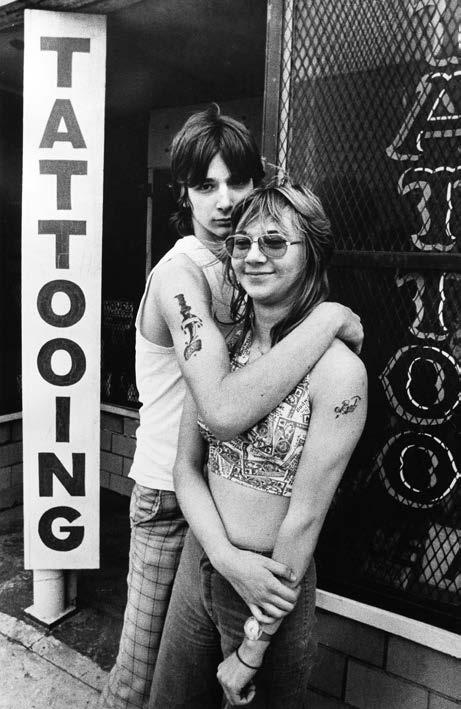
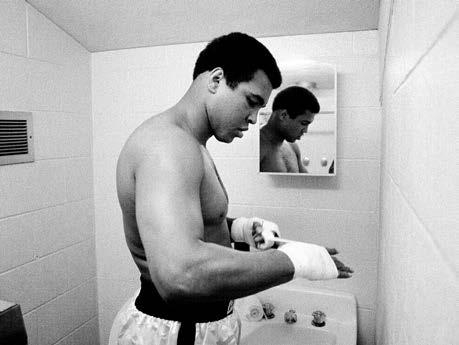
“I turned them all down—every single one of them down—to go to what was my dream newspaper, who I felt had the finest photo staff in America: the Courier Journal here in Louisville,” Dry says. His original offer of a three-month temporary appointment became a five-anda-half-year commitment that played an integral part in shaping his future.
Among other roles in his prolific career, Dry was a contract photographer for National Geographic for 10 years, owned his own corporate and advertising studio, and worked under contract with the creative team in University of Chicago’s Office of Development. Today, he is the managing director of the Creative Content Studio at Louisville-based advertising agency PriceWeber, a role he’s held for nine years, and has served as an official photographer of the Kentucky Derby for 46 years.
Over the course of his career, Dry has won more than 500 national and international photography, advertising and design awards, making him one of the nation’s most awarded photographers. His accolades include NPPA Newspaper Photographer of the Year and induction into the Ohio Communications Hall of Fame at Ohio University.
“Dan Dry is a trailblazer in the field of photojournalism. His award-winning work is a testament to his skill and creativity,” says University President Lori Stewart Gonzalez. “We are thrilled to receive such a vibrant and rich collection of his work, which will provide an important glimpse into OHIO history for many years to come. We are forever grateful for Dan’s generosity and are honored to have his collection at OHIO.”
As an Athens native, Dry is proud to continue supporting and connecting with OHIO as “a school that breeds excellence,” highlighting the uniqueness of its location in the heart of Appalachia.
“I’ve been to a whole lot of college towns,” he says. “I’ve lectured at colleges and universities across the country and, in my opinion, for what it is and what it does, [OHIO] is in a league by itself … starting with President Gonzalez and going down to the custodial staff and everyone else in between. Everyone who works there has a pride in themselves, a pride in what they do and a pride in the University.”
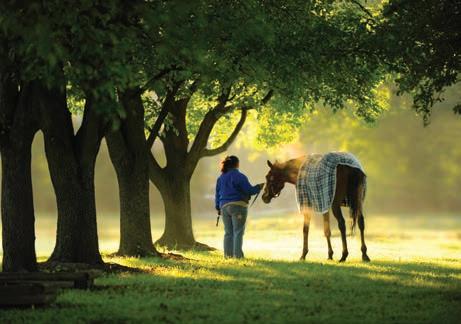
Among Dry’s many career achievements is a 46-year stint as photographer of the Kentucky Derby. PHOTO COURTESY THE DAN DRY COLLECTION IN THE MAHN CENTER FOR ARCHIVES & SPECIAL COLLECTIONS
For the Dry family, their gift of the Dan Dry Collection, as it will be known, is a way of sharing memories and carrying on legacies.
“When I look back on everything that is in that collection, it’s so many memories that I want to share,” Dry explains. “It’s 50 years’ worth of work, and there are photos in there of me and my parents, and me and my family, and my daughters as they grew up. It’s a legacy that I wanted to share with the community and the University that has made me into the professional person that I am today.”
The personal nature of Dry’s collection will provide important knowledge of Athens and OHIO history through the lens of one noteworthy alumnus.
“Dan Dry is an extraordinary example of what an OHIO education can inspire—his remarkable career includes work that spans both photojournalism and commercial photography,” says Scott Titsworth, dean of Scripps College of Communication. “Having his collection at Ohio University will provide a tremendous resource for students and faculty, as they exemplify the power of images in compelling storytelling. We are incredibly grateful for his support and look forward to honoring his legacy through this exceptional collection.”
For Dean of University Libraries Rob Ross, Dry’s collection documents both a place-based history and one that’s more technical.
“As an early adopter of digital photography, Dan’s collection not only contains incredible images spanning his award-winning career, but it also documents technical and professional changes in photographic practice,” Ross says.
Laura Smith, photo archivist and curator of the Documentary Photography Archive in the Mahn Center for Archives and Special Collections at Ohio University Libraries, is leading the work to organize, describe and make accessible Dry’s work. Once processed, the collection will be open to anyone with an interest in photography or the subjects captured by Dry’s lens.
“Dan’s deep connection to Athens and the OHIO community is a wonderful entry point for students,” Ross adds. “The collection offers students a way to see themselves in the work of an accomplished
photographer, whether imagining themselves in their future professions or recognizing their time in Athens and Ohio University. We look forward to seeing students, faculty and the community engage with this exciting collection.”
Ultimately, that’s what it’s all about for Dry and his family. With this gift, they are paying forward their appreciation for and pride in OHIO to a community they hold dear.
“I’ve been fortunate enough to wake up and do what I love—photography—every day since I was 15 years old,” Dry says. “I get up every morning in anticipation of all that and anticipation of paying it forward. I’ve worked my tail off; there is no question. I have just been so blessed in my life, and I want to share that in every way that I can. Am I a proud Bobcat? You are daggone right. As proud as they come.” —Julia Weber, BSJ ’25
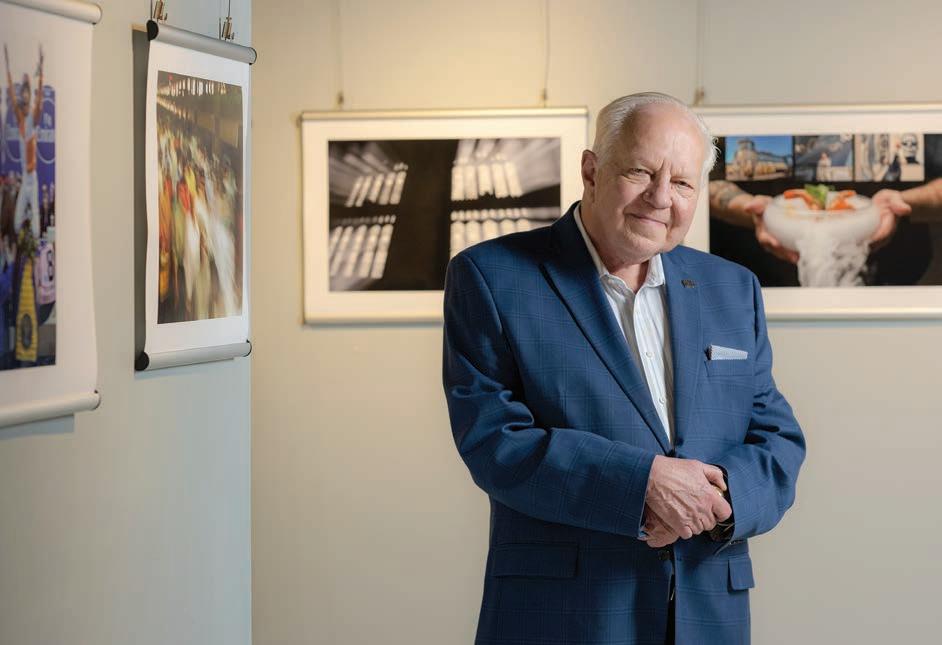
The history of Ohio University Libraries is almost as old as the University itself. In 1811 and 1812, OHIO purchased its first books. The combined $600 price tag was steep—more than it cost to erect the University’s first official building. The Board of Trustees officially established the Library of Ohio University in 1814, but it would be another four years before it got a real home. Read on to learn how that small set of books grew into one of the 100 largest academic libraries in the nation … and the homes it’s had along the way. —Emma Frankart Henterly BSJ ’10
1818-1905
(Later the Center Building, now Cutler Hall)
The collection grew tremendously during its nearly 90 years in the building that also housed classrooms, a dormitory and a museum. In 1901, President Alston Ellis declared the 15,000-plus books a fire hazard and insisted that something had to be done.
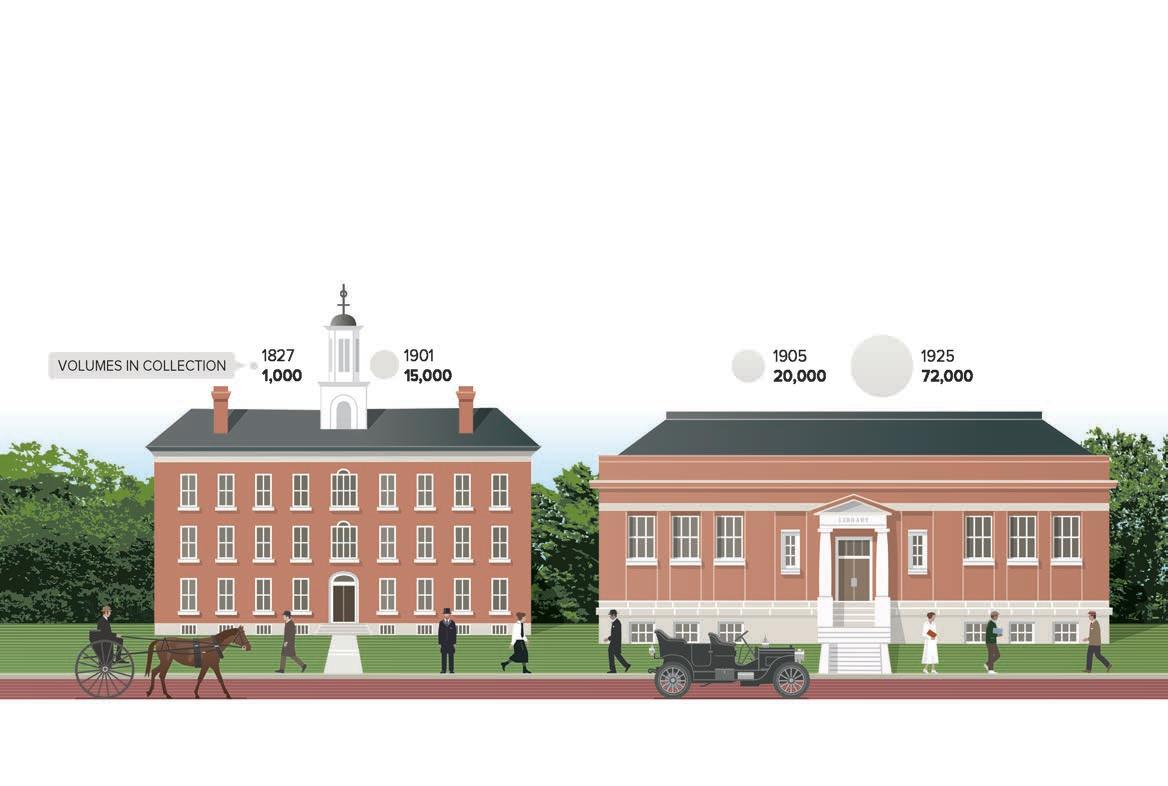
1905-1931
(Now Scripps Hall)
Though beautiful, the building funded by steel baron Andrew Carnegie was insufficient from the start; as a result, it was the library system’s shortest-lived home. It featured a card catalog and reading rooms, but the large rotunda and foyer took up precious real estate, and documents were piled throughout the building as a result.
The collection had seen both its longest and its shortestlived homes by the time Chubb Library was completed, with capacity for 250,000 volumes. It featured a children’s room, a smoking/study room, an open stack policy that let patrons locate their own materials, and eventually such modern
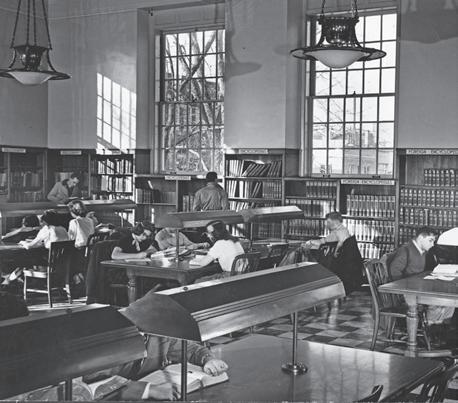
technology as a Xerox machine and a rentable typewriter. The building was named for Edwin Watts Chubb, an English professor who became dean of the College of Liberal Arts (now the College of Arts and Sciences) in 1907 and who served as acting president on two occasions.
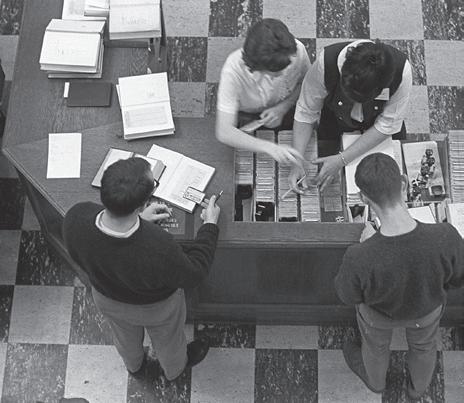
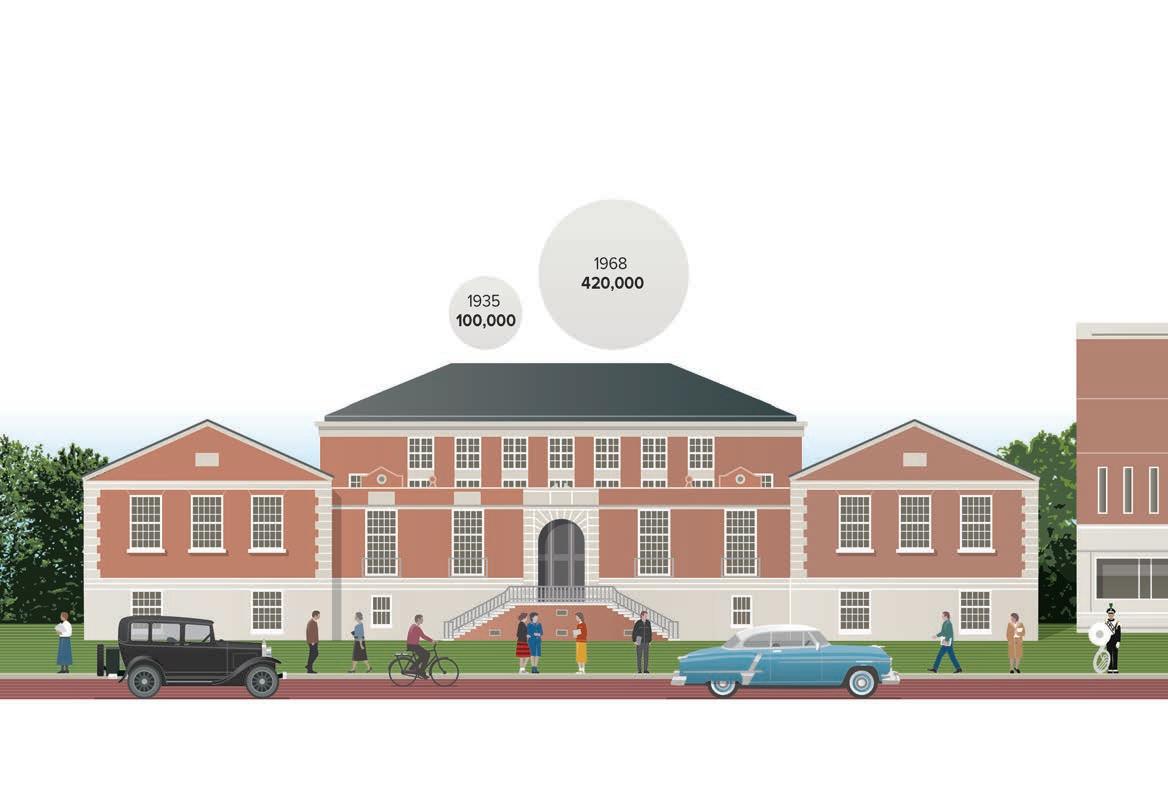
When Vernon R. Alden became OHIO’s 15th president, he prioritized a new library to house the University’s half-millionplus books, which were moved from Chubb to their new home via rolling conveyor belts and a tractor. The east and west wings were completed in 1972, but the building exceeded capacity (1.4 million volumes) in 1985; the Library Annex opened on
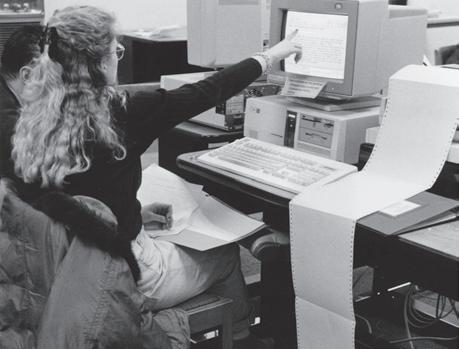
Columbus Road in the ’90s to house lesser-used materials and now bears the name of Libraries Dean Emeritus Hwa-Wei Lee. Today, Alden Library is home to several material collections, the Academic Achievement Center, a multimedia studio, study and meeting rooms, a café, the CoLab makerspace and 3D printer lab, an IT service desk and, of course, plenty of books.

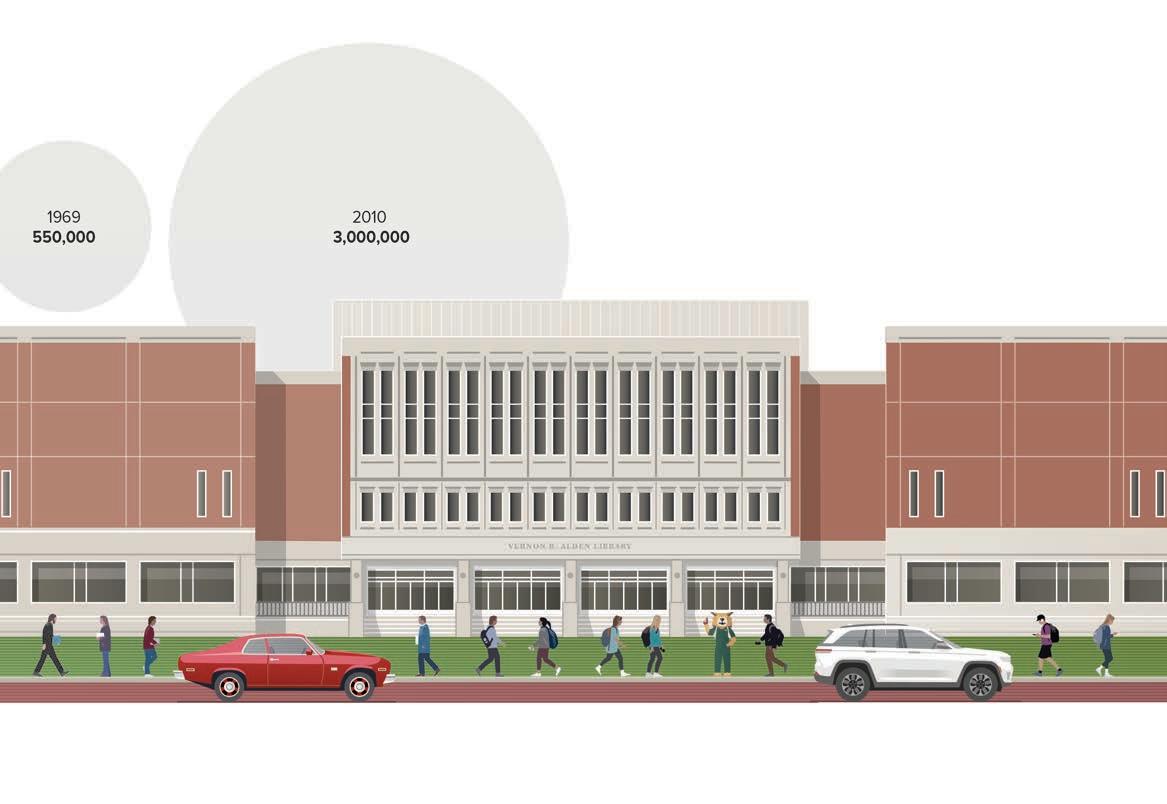
Exploring the shared past of humans and our animal brethren
Until the lion has his own historian, the tale of the hunt will always glorify the hunter.
—AFRICAN PROVERB
If history is written by the victors, this African proverb describes that history as one that involves animals as much it does humans. As a species, humans are not alone, but our history has been written as though we have been.
In a new book published by the Ohio University Press, historian Sandra Swart argues that human history is incomplete unless it acknowledges our relationship with animals. Written for both general and scholarly audiences, “The Lion’s Historian: Africa’s Animal Past” introduces readers to a Noah’s Ark of species to show how closely intertwined our histories are.
Swart, a professor at South Africa’s Stellenbosch University, insists on a multispecies retelling of our more-than-human past as she reconstructs a series of significant human-animal relationships, from quirky, idiosyncratic connections to others that triggered major environmental changes.
An interdisciplinary background in history and environmental studies influences Swart’s work.
She combines the natural sciences with social sciences, oral history, indigenous knowledge and archival research to tell these histories in engaging and accessible language. She blends current thinking about animal sentience, agency, cognition and emotion to offer a new way to understand animals’ role in our shared history.
The animals in this book—baboons, elephants, hippos, horses, jackals, lions, okapi, quagga, white ants and more—exemplify different facets of our shared past. While Swart’s book focuses on South Africa, its lessons are globally relevant. With this animal-centric lens, decades of research come together in a book that takes animals seriously. It is a book with claws and fangs that asks, “Are we prepared to move beyond the convention that ‘history’ is the story of only our own species?”
The entanglements between humans and other animals have shaped our past, but they suggest something more: The possibility of our shared future pivots on a reckoning with our shared past. Swart shows what humananimal history can do, not only to understand our place in the world better but also to make our world—however slightly—a better place. —Laura André is the publicity and metadata manager at the Ohio University Press
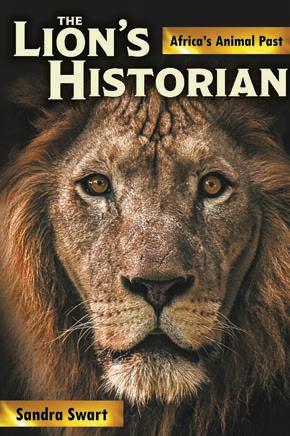
“ ‘The Lion’s Historian’ offers a treasure of fresh thinking about the African past. With creativity, insight and an inimitable voice, Sandra Swart demonstrates, repeatedly and richly, the rewards of taking animal actors seriously.” —Nancy Jacobs, Brown University

A STRATEGIC PARTNERSHIP IS ELEVATING CONSTRUCTION MANAGEMENT EDUCATION AT OHIO UNIVERSITY.
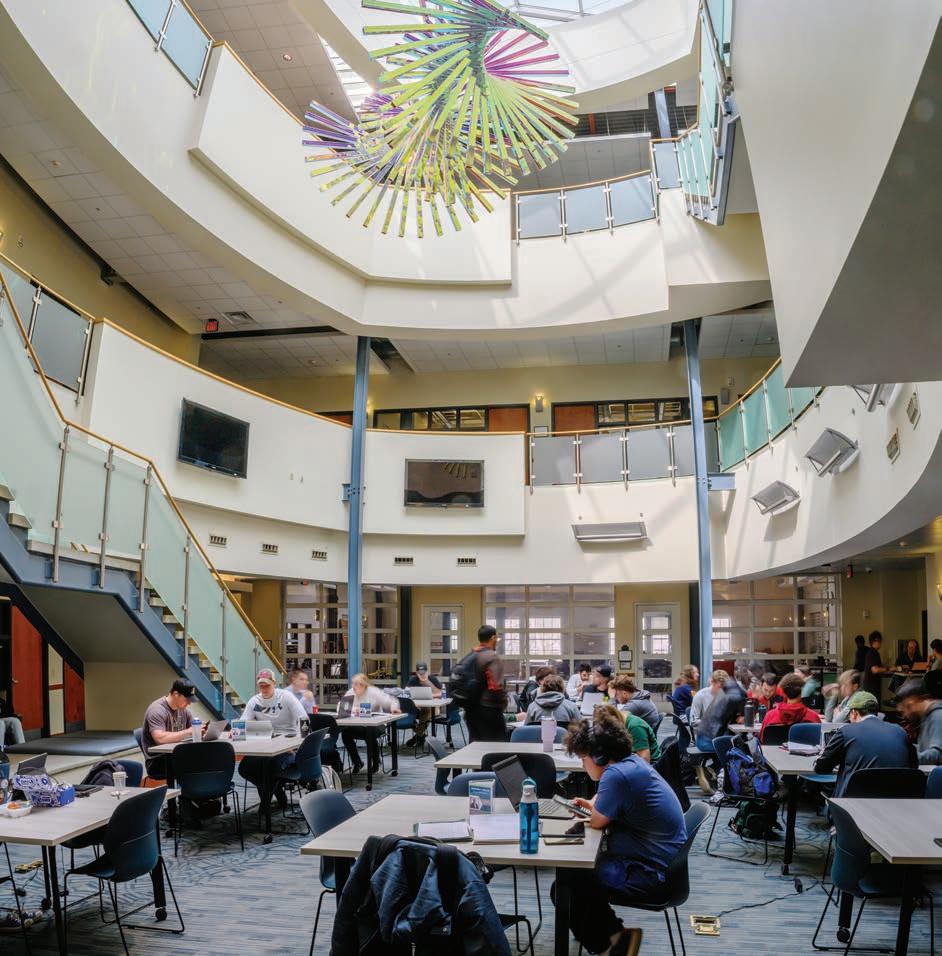
Civil engineering students examine plan sets in a Construction Estimating & Equipment class. PHOTO BY TY WRIGHT, BFA ’02, MA ’13

Kokosing, Inc., has long recognized that skilled, experienced workers are key to successful construction projects. Their recent support of Ohio University’s Russ College of Engineering and Technology demonstrates this commitment, leading to the naming of the Kokosing Teaching Laboratory—a critical resource for students in the construction management certification program.
Located in room 116 of the Charles R. and Marilyn Y. Stuckey Academic and Research Center, the laboratory is a spacious, two-story space that’s highly visible thanks to its proximity to the building’s atrium. It is designed to provide students with the space and resources they need to gain practical understanding of various aspects of construction management.
“Hands-on training is essential for developing realworld skills,” says Bryce Burgett, co-CEO of Kokosing. “Having practical experience in a facility like the OHIO training lab allows students to work with tools, equipment and programs that directly translate to a successful career in construction.”
The Kokosing Teaching Laboratory enables students to work on projects that simulate real-world challenges, such as building structures, laying foundation slabs and managing infrastructure improvements. This partnership ensures students develop the skills necessary to succeed in the construction industry.
Kokosing’s collaboration with Ohio University reflects the family-owned company’s commitment to addressing the construction industry’s evolving needs. “Our partnership with education programs allows for a shared focus on the current and future demands of construction,” Burgett explains. “By aligning efforts, we are working toward the common goal of developing career-ready individuals.”
Kokosing’s core values of safety, quality and community involvement are reflected in its support for construction management education.
“Our passion for ‘Safety 24/7’ is central to everything we do,” Burgett says. “By supporting education programs with the knowledge and tools to do the job safely, we are shaping the next generation of professionals who will directly impact safety at Kokosing and beyond. Operating with honesty and integrity is fundamental to Kokosing, and we are proud to partner with Ohio University, which shares these principles.”
Thanks to Kokosing’s support, students in Russ College have advanced experiential and hands-on learning opportunities to develop skills needed to meet the workforce demands of the region and state.
“The Kokosing Teaching Laboratory will greatly enhance hands-on experiential learning for our construction management certification program, embodying the collaborative spirit between industry and education,” says Patrick Fox, dean of Russ College. “This partnership is vital in developing the skills our students need to succeed in the industry today.”
Through this collaboration, Kokosing is helping to foster a new generation of construction professionals equipped with essential technical skills and safety practices.
“By providing students with the tools and knowledge to approach their work safely and responsibly, we’re cultivating future leaders in the construction industry,” Burgett says.
As students step into the Kokosing Teaching Laboratory, they’re stepping into the future of construction. With every lesson they learn, they’re building more than just structures; they’re building a promising future.
—Douglas Dennis

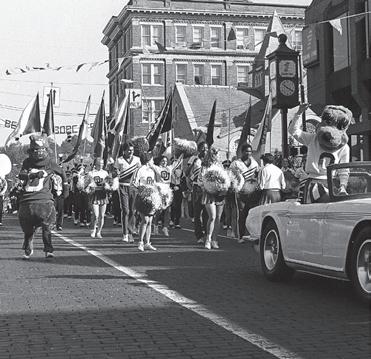
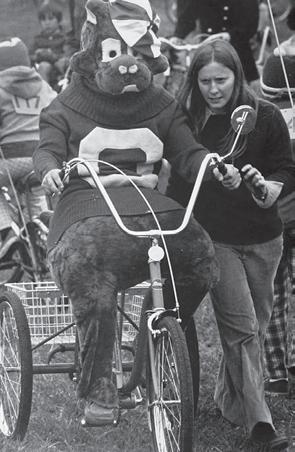
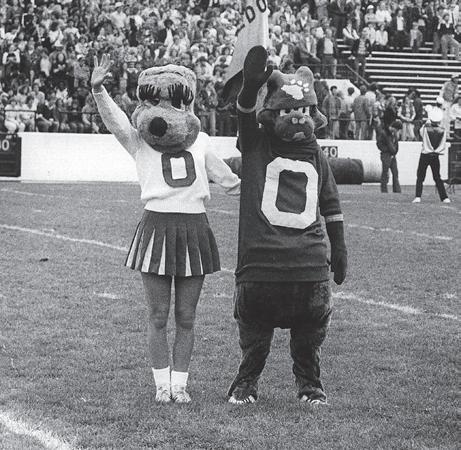
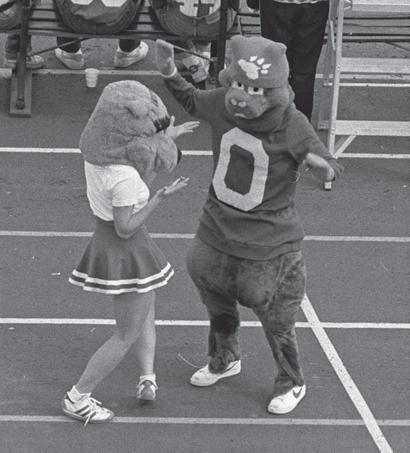
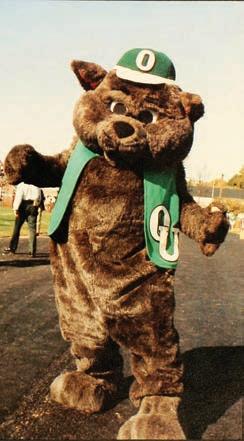
Until 1925, the University’s athletic teams were without a mascot, usually referred to with unofficial nicknames—such as the football team’s moniker of “Fighting Fools,” as noted in the student newspaper, Green and White. To solve this conundrum, 2 $10 for the winner. After more than 100 entries and several meetings of the Athletic Advisory Board of the Men’s Union, former student Hal Rowland’s suggestion of “Bobcats” was selected.
The “Mr. Bobcat” costume debuted in 1960 and featured a brown, bearish-looking cat in a varsity sweater and beanie. In 1983, The Post announced that “the Bobcat has gotten a facelift.” The new costume swapped the sweater for an open vest and was seen as more collegiate, but was still cartoonish; one Post opinion writer compared it to “a chipmunk, gopher or muskrat.” The costume saw yet another redesign to a slimmer, but still somewhat silly, build in the late ’90s.
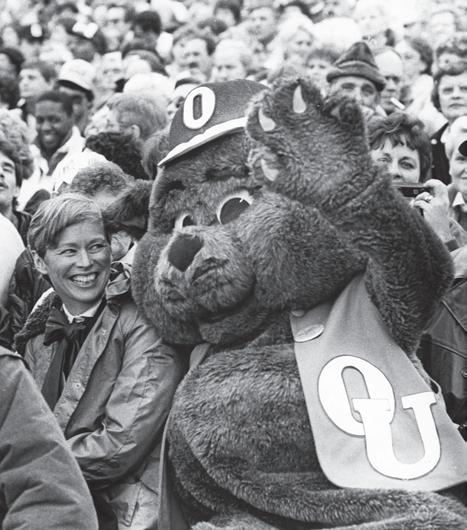
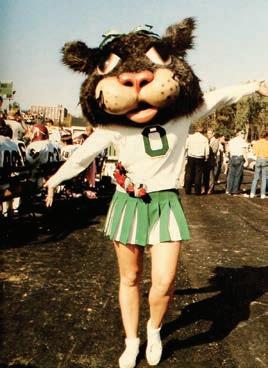
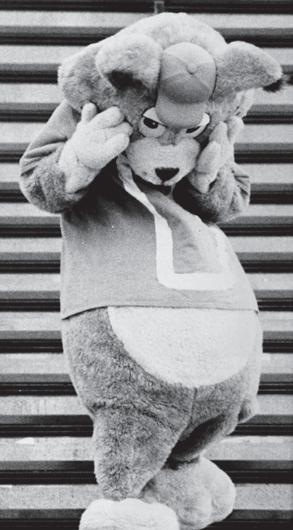
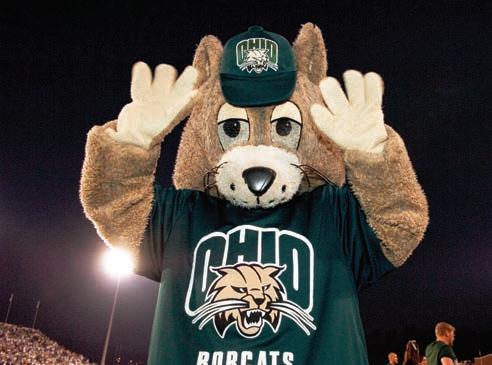
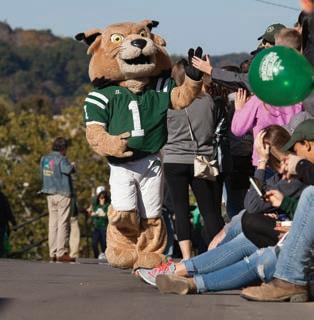
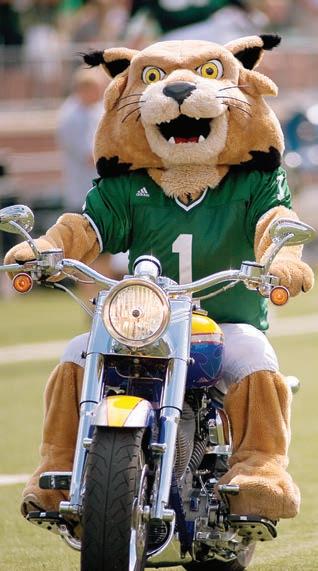
From left to right, the evolution of Mr. Bobcat to OHIO’s beloved Rufus ... with some guest appearances by his onetime companion, Bobkitten. PHOTOS COURTESY OF THE MAHN CENTER FOR ARCHIVES & SPECIAL COLLECTIONS AND OHIO UNIVERSITY PHOTOGRAPHY
During much of that time, Mr. Bobcat wasn’t the school’s only mascot. Created by all-female residents of Howard Hall, the Bobkitten was an unofficial addition to games and Homecoming parades from 1967 to 1990. Her costume included a papier-mâché head, a white sweater with a green “O” patched on, a skirt and bloomers that read “OH-IO.” The Bobkitten went dormant during the ’90s, and the costume was lost. While Bobkitten has not been seen since, women weren’t left out of mascot lore entirely, as in 1995 a female student—Dana (Hudson) Kelly, BSC ’99— donned the official Bobcat costume for the first time.
In September 2006, the University debuted the Bobcat we know and love today. Rolling into Peden Stadium on his motorcycle, the revamped mascot was slimmeddown, tougher-looking and sported the name “Rufus,” a reference to both the species name for the bobcat, Lynx rufus, and University co-founder Rufus Putnam.
After 100 years and many changes, Rufus the Bobcat stands as a beloved feature of OHIO, reflecting the spirit of the University and its students. Here’s to 100 more. —Taylor Connelly, BSJ ’26
Class Notes
* denotes accolades featured at ohio.edu/news or in the media
Gary Croy, BSED ’62, received the 56th annual Grindstone Award, presented by the Berea (Ohio) Chamber of Commerce to those with outstanding contributions to the community.
As of his 74th birthday on June 5, 2024, Joel Cross, BBA ’72, had fitness walked for 1,624 consecutive days—nearly four and a half years—averaging 11 miles per day.
R. Marc Kantrowitz, BA ’72, MA ’74, was inducted into the Massachusetts Lawyers Hall of Fame. Kantrowitz has worked as an assistant district attorney, juvenile court judge and higher education instructor; he also is a highly published author on numerous topics.
On Feb. 13, 2025, Mike Schmidt, BBA ’72*, was inducted to the College Baseball Hall of Fame as part of the 2024 class of honorees. He is also a member of the Ohio Athletics Hall of Fame (1977) and MAC Hall of Fame (2012).
Two OHIO alumni were inducted to the Greater Cincinnati Society of Professional Journalists’ Journalism Hall of
Fame last August: John Popvich, BSC ’73*, and Ken Broo, BSC ’74* Popvich retired in 2019 after a 40-year career with WCPO-TV, while Broo’s nearly 50-year career at radio and TV stations in Cincinnati and beyond has included time as the play-by-play voice of the Cincinnati Bengals Radio Network.
Tire Business special projects reporter Bruce Davis, BSJ ’79, was named the 2024 Outstanding Individual Contributor by parent company Crain Communications Inc. In his 40-plus-year career with Crain, Davis also worked on sister publications Rubber & Plastics News, European Rubber Journal and Urethanes
Technology.
Last June, longtime Central Ohio football coach William “Ed” Terwilliger III, BSED ’79*, was inducted into the Ohio High School Football Coaches Association’s Hall of Fame. Terwilliger won 138 games during his 24 years as coach at Olentangy High School.
On Aug. 3, Ohio Gov. Mike DeWine appointed Richard “Dick” Dickerson, BSCE ’80*, to the Ohio University Board of

Last year, the Great Lakes Chapter of the National Academy of Television Arts and Sciences honored Terra Brantley, BSC ’86*, with a Silver Circle Lifetime Achievement Emmy. Brantley is an evening news anchor at WFFT Fox 55 in Fort Wayne, Indiana, where she has the distinction of being the longest-serving Black news anchor in the state’s history. The award recognizes Brantley’s nearly 40 years of accomplishment and dedication to providing information and a support system for her community.
“I’ve been able to use my personal struggles with domestic violence in my first marriage to inspire others to break the cycle,” she says. “I have shared my personal story at many events; I’ve helped women and men seek help. Being … a journalist who they trust has helped me champion that cause.”
Brantley also is a member of the Indiana Associated Press Hall of Fame and has earned multiple awards from the Indiana Associated Press and Society of Professional Journalists.
Trustees for a term lasting through May 2033.
Dianna Vargo, BS ’81*, was named the 14th president of Wheeling University in West Virginia. Previously, Vargo served as Wheeling University’s chief operating officer.
Virginia Tech’s radio station, WUVT, played “Sweet Mary” and “You Play the Hand You’re Dealt,” original songs by Hazel Beeler, MS ’82. While the airtime
was thrilling, Beeler mostly enjoys playing her music with friends, on her porch or in her living room.
Milbert “Milt” Brown Jr., MA ’82*, was inducted into the National Association of Black Journalists Hall of Fame. Brown was recognized for his talent and dedication to storytelling over a decades-long career, which includes a 2001 Pulitzer Prize awarded to Brown and his Chicago Tribune colleagues for their coverage of America’s complicated air traffic system.
1983
Mark E. Sigrist, BBA ’83*, was elected to represent House District 10, which includes Grove City and parts of southern and southwestern Ohio. The former Grove City Councilmember began his term at the Ohio Statehouse in January.
1984
William “Byl” Herrmann, AB ’84, is the new executive vice president and general counsel for Amtrak, where he’s worked for the last 25 years.
Zanemvula “Zakes” Mda, MFA ’84*, made The New York Times’ Book Review’s “Best Books Since 2000” list last May with not one, but two titles: his novel “The Heart of Redness” and the nonfiction “Sometimes There is a Void: Memoirs of an Outsider.”
A former ambassador to Australia and Canada, Maris Sangiampongsa, MA ’84*, became Thailand’s minister of foreign affairs after receiving endorsement from the Thai king for his spring 2024 appointment.
Paul Carringer, MBA ’86, presented at the Raymond E. Mason Jr. Leadership Symposium, an annual event of the Franklin Uni-
versity Leadership Center in Columbus, Ohio. His session, titled “AI Today: Using AI Today for Organizational Impact,” provided an overview of recent AI conferences, industry studies and reports.
Former WOUB sports anchor Suzanne Hargrove, BSC ’86*, was named Executive Producer of the Year at the Ad Age A-List and Creativity Awards. The vice president and executive producer at Los Angeles-based PRETTYBIRD was honored for her “skill, attention to detail and humanity.”
The National Tax Lien Association has appointed Austin B. Barnes III, BBA ’87, as the organization’s new general counsel. Barnes is an attorney at Sandhu Law Group and specializes in tax lien and mortgage foreclosures.
The founder of Passion Works Studio, Patty Mitchell, BFA ’87, MFA ’91*, was acknowledged by CNN’s “Champions for Change” series for creating a space “where artists with developmental differences collaborate to create marketable works using otherwise discarded materials.”
1988
The Board of Directors
Alumni Authors
OHIO alumni publish books across subjects and genres. Here are releases within the last year.
Black and White, Blue and Gold, crime fiction (selfpublished), by Jason “Jay” Bender, BSJ ’89 · Social Media and Digital Politics: Networked Reason in an Age of Digital Emotion, sociology and political science (Routledge), by Jeffrey Layne Blevins, PHD ’01, and James Jaehoon Lee · The Florida Vegetarian Cookbook, cookbook (University Press of Florida), by Dalia (Wheatt) Colón, BSJ ’03 · The Slow Down, interior design (Abrams Books), by Leanne Ford, BSS ’03 · Artistic and Life-Like: Photography in Washington, 1850-1900, history (Grey Day Press), by Tim (Daum) Greyhavens, BFA ’70 · The Prop Building Guidebook: For Theatre, Film, and TV, craft and DIY (Routledge, third edition), by Eric Hart, MFA ’20 · Her Pretty Lies and The Perfect Affair, thriller (Storm Publishing), by Angela Henry, AB ’92 · Less Helping Them / More Healing You: The Transcendent Gift of an Ancient Spiritual Tradition, self-help/spiritual memoir (ACTA Publications), by Jean Kelly, PHD ’03 · Star Late Rising, fiction (Dorrance Publishing Co.), by R. (Ron) Luce, MA ’82, PHD ’89 · The Transformative Journey of Higher Education in Prison: A Class of One, social science, legal system and higher education (Routledge Academic Press) and Witness: An Insider’s Narrative of the Carceral State, social science and legal system (Haymarket Books), by Lyle May, AA ’13 · Whatever Happened to Frankie King, graphic novel (Graphic Mundi), by Eli Neugeboren, BFA ’97, and Jay Neugeboren · An Augury of Birds, poetry (Redhawk Publications), by Scott Owens, AB ’84 · Emergency Management Threats and Hazards: Water, emergency and disaster management (CRC Press), by Michael Prasad, BBA ’87 · Root and Bone, fantasy/murder mystery (Cursed Dragon Ship Publishing), by Jessica Raney, BS ’97 · Hiking Waterfalls Ohio: A Guide to the State’s Best Waterfall Hikes (FalconGuides) and Hocking Hills Day Hikes (Get Out! Publishing, second edition), nature guides by Mary Reed, BSJ ’90, MA ’93 · Discovering Vienna, West Virginia: Origins. History. Heritage., local history (Friends of Vienna) by Christina Ullman, MS ’97 · Iridescent Pigeons, poetry (Yellow Arrow Publishing), by Candace Walsh, PHD ’24 · The Philosopher’s Wife, historical fiction (Stone Ring Press), by Edwin Wollert, MA ’98
Send your published work updates to ohiotoday@ohio.edu or to OHIO Today Magazine , Ohio University, P.O. Box 869, Athens, OH 457010869. And don’t forget to add your achievement to the Ohio University Alumni Association’s Bobcat Authors database at ohio.edu/alumni/ bobcat-authors.
of sports apparel powerhouse Nike announced last fall that Elliot Hill, MSA ’88*, is the brand’s new president and chief executive officer. Hill is no stranger to Nike; prior to his retirement in 2020, he held senior leadership positions at the company across North America and Europe.
After securing a March primary to run unopposed in the November general election, Matt Chafin, BSC ’89*, took office as judge of the Pickaway County Common Pleas Court in January. Chafin was most recently chief legal counsel at the Ohio Department of Transportation and a board member of the Pickaway County Community Foundation.
Jennifer Mayer, BSC ’89, is proud to announce that
the 2024 documentary “Carol Doda Topless at the Condor,” which she edited, is now available on Apple TV and Amazon Prime after appearing in theaters across the country.
Mitchell J. Silver, DO ’89, has joined Contego Medical as chief medical officer. A renowned interventional cardiologist and vascular medicine specialist, Silver will be a key part in advancing Contego Medical’s portfolio of carotid and thrombectomy products.
The latest film from Sheri (Martis) Ward, BSJ ’90, “Black Uniform,” was awarded Best Documentary at the Orlando Urban Film Festival and Diamond State Black Film Festival, as well as Best Historical Documentary at the Manhat-
tan Film Festival. The film tells the story of 12 Black veterans and is streaming on Amazon Prime.
Last summer, Kris Crenwelge, MSA ’91*, was selected as a fellow of the seventh annual Native American Feature Film Writers Lab, a talent development program that boosts the careers of Indigenous writers.
Attorney Michael Elliott, AB ’91, recently joined Roderick Linton Belfance, LLP as a partner. He brings 26 years of experience representing individuals in a variety of employment, personal injury and other litigation matters.
Three-term incumbent Julie (Olson) von Haefen, BSJ ’92*, was re-elected
to represent District 36 in the North Carolina House of Representatives. The Democrat’s platform included pledges to support public education, lower health care costs, workforce investment and more.
Katrina Bell-Jordan, BSJ ’93, MA ’94, PHD ’97*, is the new president at Northern Illinois University after filling the role in an interim capacity for the last year. NIU’s eighth president previously served as an assistant professor and chair in its Department of Communication, Media and Theatre and associate dean of its College of Arts and Sciences.
Prospect League Baseball has named Chillicothe Paints President Bryan Wickline, BSSE ’95*,
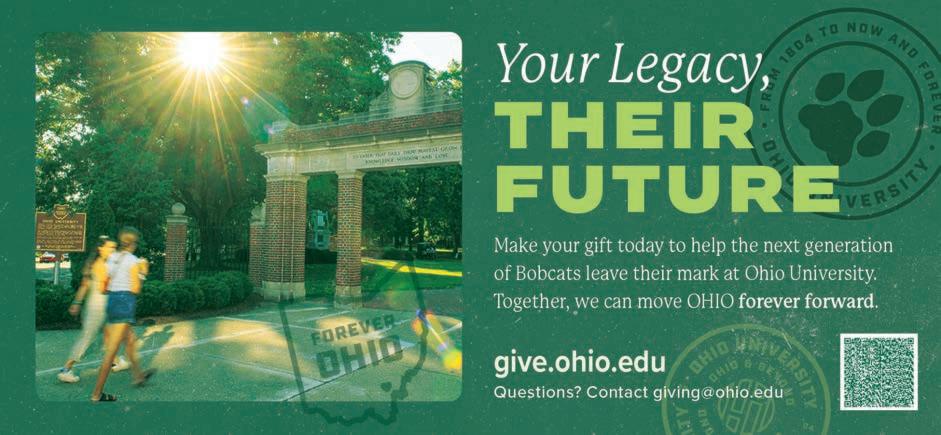
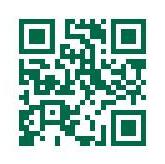
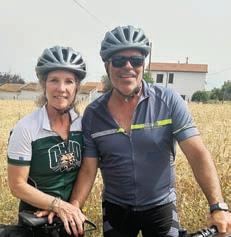
College buddies Matthew “Cenky” Laws, BSS ’07, MSA ’14 (left) and Aaron “Herk” Herkenhoff, BSCE ’08, paid homage to George R.R. Martin’s Game of Thrones when they visited Dubrovnik, Croatia, with their wives last spring. The Old Town neighborhood seen behind them served as the setting for King’s Landing in the HBO adaptation of the series.
Carolyn (McLaughlin)
Cuppernull, BSJ ’86, celebrated her 30 th anniversary with her husband, Gary, on a “backroads Tuscany by the sea” bike tour last summer—in OHIO attire, of course!

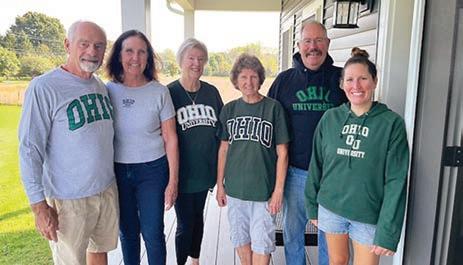
A contingent of Northeast Ohioans ventured to Rochester, New York, for a mini-reunion last fall. Pictured from left to right are Robert “Bruce” Berry, BBA ’73; Pat (Huntington) Berry, BSED ’73; Denise Morgan; Kathy (Westerman) Liszkay, BSED ’72; Andrew Liszkay, BSCHE ’73; and Tracy (Liszkay) Smith, BA ’03
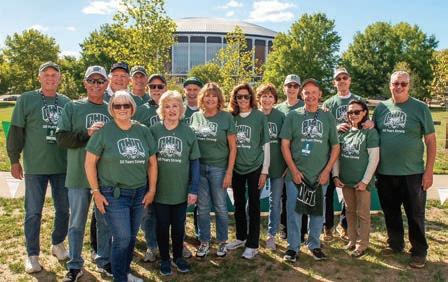
This crew celebrated their 50 th reunion at OHIO last fall! Pictured in the back row, from left to right, are Ed Kurtz, BBA ’74; Joe Janson, BSED ’74; Jerry Ellsesser, BBA ’74; Russ Gantos, BSJ ’74; John Hinze, BSEE ’75; Gary Loy, BBA ’74; Darlene (Brogan) Stetson, BSC ’75; Genie Sullivan, BSED ’74; Steve Rosenberg, BSJ ’94; and Richard Strauss, BBA ’74. In the front row, left to right, are Bettie (Baumholtz) Janson, BSED ’74; Cheryl Hinze; Bernie (Schrader) Kurtz, BSJ ’74; Sue Stiner, BSHEC ’75; Mike Murphy, BSC ’75; and Renee Rosenberg.
New Hampshire National Guard members Will Mullins, PHD ’16, and Jill Sabatine, BA ’86, both deployed to the Middle East in 2023, where Mullins served as a chaplin and Sabatine as a behavioral health officer.

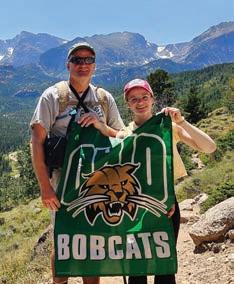
Two generations of Bobcats explored Rocky Mountain National Park in Colorado last summer: Kevin Pinson, BSJ ’92, and his daughter, Caroline Pinson, who is finishing up her sophomore year studying biological science with a minor in chemistry.
Send your photos with names, grad degrees and years to ohiotoday@ohio.edu or to OHIO Today Magazine , Ohio University, P.O. Box 869, Athens, OH 45701-0869.
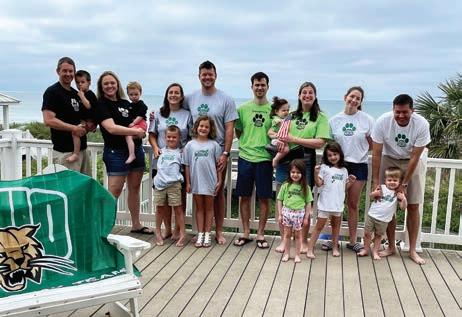
For Memorial Day week 2023, four former roommates, their husbands and their Future Bobcats gathered for a vacation in Ocean Isle Beach, North Carolina. Pictured in black are Jason Chandler, MBA, MSA ’08, holding Evan Chandler, and Caitlin (Brown) Chandler, BBA ’07, holding Catherine Chandler. In gray shirts are Danielle (Paulozzi) Roberts, BS ’07, behind Everest Roberts, and Chris Roberts, BA ’07, behind McKinley Roberts. In green are Mark Galiette and Kimberly (Kanner) Galiette, BSC ’08, holding Sophia Galiette with Lilly Galiette standing in front. And in white are Caitlin (Miller) Jacobs, BSC ’08, with Miller Jacobs in front of her, and Michael Jacobs, MBA, MSA ’08, with Leo Jacobs in front of him.
Jillian Drcar was born June 15, 2024, to Stephanie (Judson) Drcar, BA ’08, and John “JD” Drcar, BSS ’08, who can’t wait to take her to Athens and get her a sandwich from Bagel Street Deli.

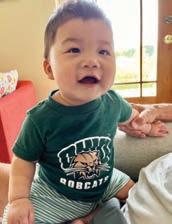
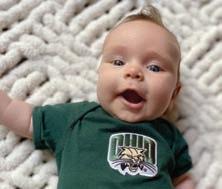
Saoirse Elise Carmen Sekula loved posing in her OHIO finest on a recent sunny day. She’s the daughter of Lauren (Sirpilla) Sekula, BSC ’06, and Tim Sekula, BSED ’02, MS ’07
Katie Kostohryz, PHD ’11, is thrilled to announce the adoption of her foster son, Di “Tank” Kostohryz, last June. He joins a long line of OHIO grads, including his grandparents Tom Kostohryz, BS ’72, BSED ’74, MS ’77, and Barb Kostohryz, BSED ’74, MED ’78, as well as cousins, aunts and uncles.
Send your photos with names, grad degrees and grad years to OHIO Today Magazine, Ohio University, P.O. Box 869, Athens, OH 45701-0869 or to ohiotoday@ohio.edu.
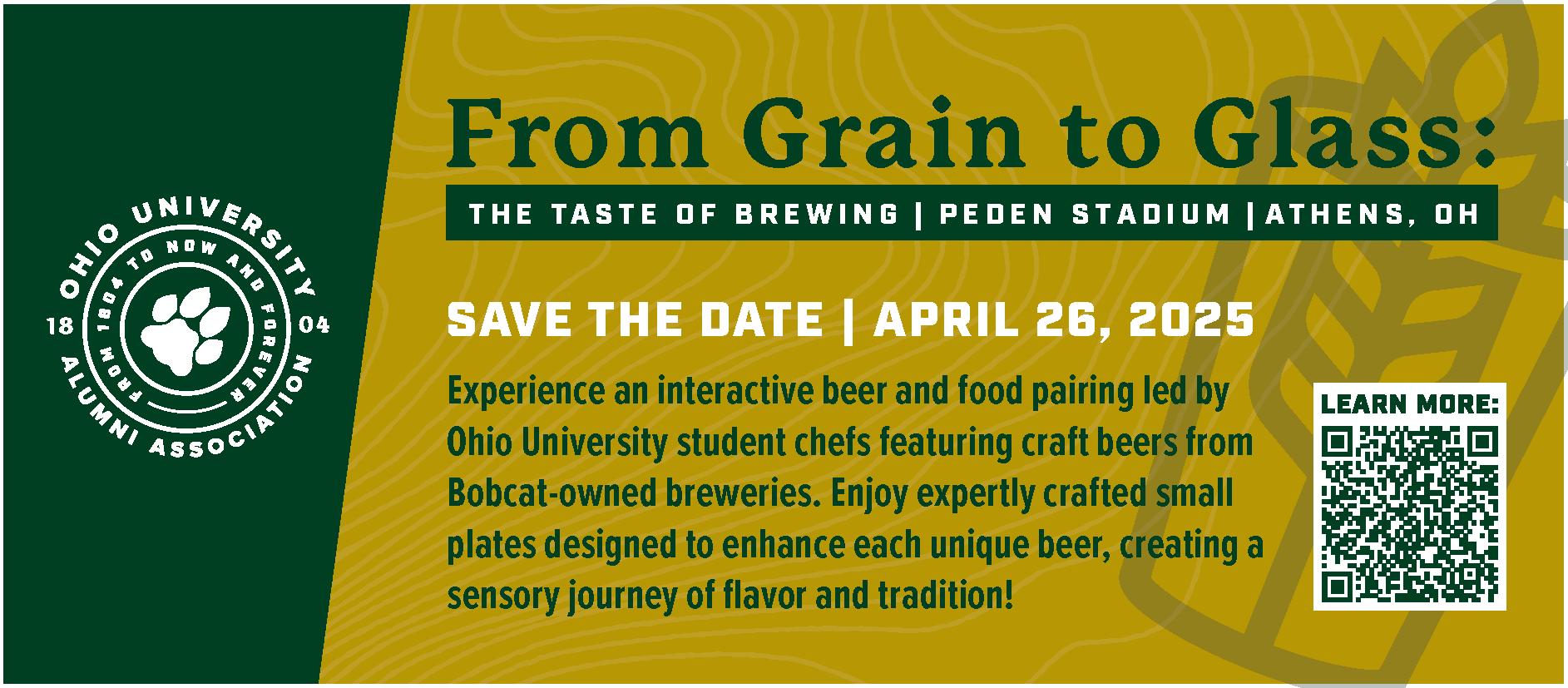
as its General Manager of the Year. The award is given to team executives who have a high impact on their team and community during the 2024 season.
The Blue Devva, a threepart limited TV series written by Daryl Malarry Davidson, AA ’96, BSS ’97, PHD ’20, was selected as a quarterfinalist in the 2024 Page Turner Screenplays competition. Set mainly in the 1950s, the drama centers on a dancer of Ugandan and Indian descent who becomes an international star.
Ullman Design, owned and operated by Christina Ullman, MS ’97, received an Award of Excellence from Creative Quarterly for the design of her book, “Discovering Vienna, West Virginia: Origins. History. Heritage.” The book provides a visual history of the Briscoe and Spencer families, who founded the city in the late 1700s.
Former WOUB hockey producer Theresa “Teri” (Guinan) Rozic, BSC ’98, has earned her sixth Emmy for her contributions to Super Bowl LVIII, which took home the Outstanding Technical Team Event award.
Incumbent Democrat Greg Landsman, BA ’99*, kept his seat as U.S. Representative for Ohio’s 1st Congressional District, which includes Cincinnati and Warren County. Landsman is the first Democrat to be re-elected for a second term in District 1 in more than 30 years and only the second to do so in the last 150 years.
Though she majored in magazine journalism, Christina Xenos, BSJ ’02*, is making a name for herself by winning Food Network’s mystery-ingredient cooking competition Chopped in October. The former editor tapped into her Greek heritage and became a personal chef in 2017; she now owns Sweet Greek Personal Chef Services in Los Angeles.
On July 1, Christine Bhat, PHD ’03*, began her term as the 2024-25 president of the American Counseling Association. Also the chair of the Patton College of Education’s Department of Counseling and Higher Education, Bhat listed child and adolescent mental health, research to support counselors’ work, and promoting the value of counselors as key priorities for her term.
Janel Jackson, BA ’03*, was included on Barron’s fifth annual list of the 100 Most Influential Women in U.S. Finance. The list honors women who have achieved prominent positions in the financial services industry and recognized Jackson for her work as the Global Head of ETF Capital Markets for Vanguard.
The city of Knoxville, Tennessee, named Kim (Bedford) Day, BSJ ’05*, its 2024 Fountain City Woman of the Year.
Sarah Van Frank-Affrunti, BSC ’05, has been named the new general manager for Southwest Regional Water District in Hamilton, Ohio.
Equality OHIO, a nonprofit advocacy group supporting LGBTQ+ and other Ohioans, named Dwyane Steward, BSJ ’07*, as its new executive director. Previously, Steward was director of inclusive excellence, accessibility and belonging at the Ohio State University Wexner Medical Center.
Last summer, Luke Frazier, MM ’09*, served as the conductor of a performance at the Library of Congress in honor of NATO’s 75th anniversary.
The global symphony included student musicians, composers and singers from 32 NATO countries, including trombonist Ellie Abbott, BMUS ’24*
Season Journals, a guided journaling company that promotes mindfulness, mental health and relationship-building founded by Annette (Drapac) Furio, BSVC ’12, launched two new products last year: the Pregnancy Journal and the Everyday Positive Journal. The former joins keepsake products the Engagement Journal and the Marriage Journal, while the latter kicks off Furio’s Everyday Collection.
Multiple OHIO alumni, led by Annah Korpi, MS ’14*, and Lisa Wigal, BSHCS ’05, collaborated on the Alexander Inclusive Playground Project, a nonprofit endeavor to install new playground equipment that’s inclusive for children with disabilities at Alexander Elementary School in Southeast Ohio. Co-chairs Korpi and Wigal were joined by vice chair Taylor Weaver, BA ’11, MA ’14; secretary and school liaison Rich Maskiell, BSED ’04, MED ’11; Alexander Elementary School Principal Abigail Rouse, BSED ’04, MED ’11; and
Alexander Local Schools Superintendent William Hampton Jr., AB ’91, in efforts to fundraise for, plan and begin installing the equipment.
Zachary Spal, BSSPS ’15, married Michelle Stein on April 20, 2024, at the Logan Hotel in Philadelphia, Pennsylvania.
Ray Perez, BFA ’16*, earned the 2024 Outstanding Student Achievement in Contemporary Sculpture Award from the International Sculpture Center last August. His sculpture, titled “Lighthouse,” is a metaphor for the experiences of Black men navigating complex social structures and reflects Perez’s own personal journey.
Nelsonville City Auditor Taylor Sappington, BA ’16*, will be the new Athens County Treasurer after winning a whopping 93% of the vote. Sappington has been involved in Nelsonville city government since 2016.
Nina Adjanin, MSRSS ’18, MED ’20, PHD ’21*, became a fellow of The Explorers Club, an international organization dedicated to field exploration and scientific inquiry, last spring. Adjanin’s research
focuses on extreme environment and modern technology. Her “Climate Sentinels” project was featured on the cover of the fall 2022 edition of OHIO Today Magazine
The first episode of Fool-Courting Press, co-written by Ian “Iggy” Cossman, BSC ’18; Daryl Malarry Davidson, AA ’96, BSS ’97, PHD ’20; and Marc Olson, was named one of the 17 official selections of Ink & Cinema’s 2024 First 10 Pages Showcase. The comedy TV series follows a white professional basketball player who feels unappreciated and issues a controversial challenge on social media.
Brittney Williams, BS ’18, had a big 2024: After earning her Ph.D. in chemistry from Northwestern University, she was hired by the federally funded nonprofit Institute for Defense Analyses in June as a research staffer in its Systems and Analyses Center.
Asynt Solutions, founded by Archie Scott III, BSME ’19, with the goal of improving infrastructure technology worldwide, recently announced the deployment of its Ape Barrier System on the Pennsylvania turnpike. Asynt touts the composite traffic barrier as a
Breaking flight records
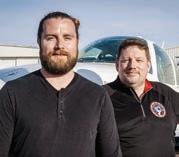
Bart Gray, BSA ’99*, Joshua Podlich, BSA ’12 , and three colleagues made history with Century Mission, a recordbreaking flight around the world spanning more than 26,000 miles and just 11 stops. The catch? They would be flying a westward route in a first-of-its-kind feat that required overcoming headwinds the entire trip.
Gray and Podlich led the venture—inspired by the first round-the-world flight, which kicked off on April 6, 1924—embarking just before midnight on April 3, 2024. It concluded, fittingly, on April 6.
The Century Mission journey took just 67 hours and 28 minutes of flight time, breaking the westward speed record in a stark contrast to the 175-day-long inspiration flight a century prior. Together, Gray, Podlich and their team showed that while technology may have drastically changed since 1924, the spirit of exploration that drove those original adventurers is still just as strong.
safer, more efficient and eco-friendly alternative to traditional pre-cast concrete barriers. Asynt got a nod from Forbes, which named Scott to its “30 Under 30 Transportation & Mobility” list for 2025.
Sisters Thelma Agyekum, BSS ’20*, and Nana Agyekum, BBA ’22*, starred in their own reality docuseries that launched last spring. Royal Rules of Ohio follows the pair, plus a third sister, Brenda Agyekum, and their parents, Yaw Owusu
Agyekum and Delali Agyekum, as descendants of two wealthy Ghanaian kingdoms. The show’s first season is streaming on Hulu and Freeform.
Jarus J. Wilson, BS ’20, graduated from the Alabama College of Osteopathic Medicine on May 10, 2024.
Send your updates to ohiotoday@ ohio.edu or to OHIO Today Magazine , Ohio University, P.O. Box 869, Athens, OH 45701-0869.
Alumni take great pride in staying connected to their alma mater, and each year, the Ohio University Alumni Association tracks the various ways our dedicated Bobcats engage with the OHIO community. Their involvement helps strengthen our reputation and further the mission of supporting students!
Learn how to become involved at ohio.edu/alumni!
96% of alumni report a good or excellent experience as a student
57,024 Alumni engaging through digital channels
Alumni that attended events
Alumni that give back financially
94% of alumni promote Ohio University to others
58% of alumni feel connected to OHIO
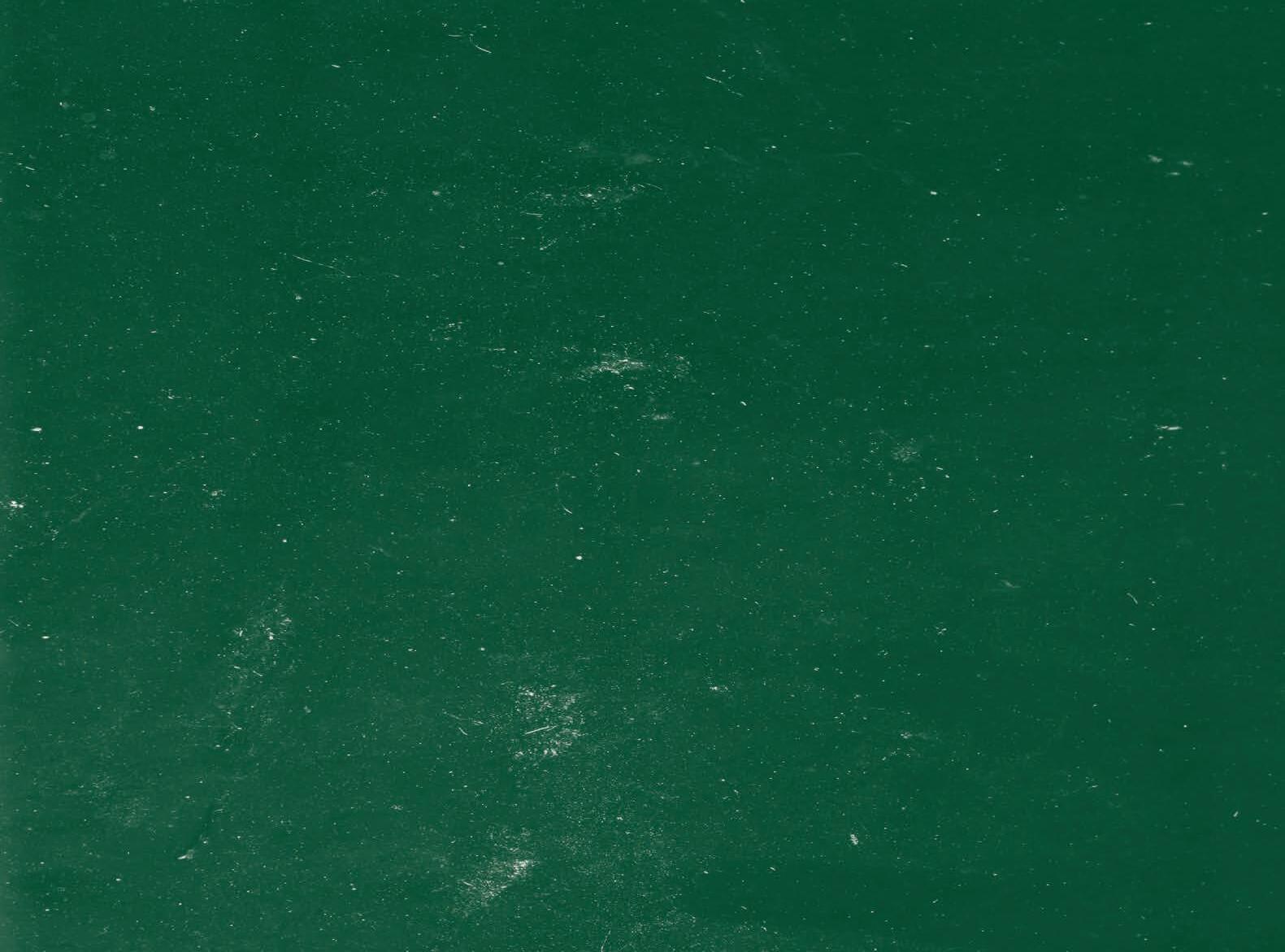
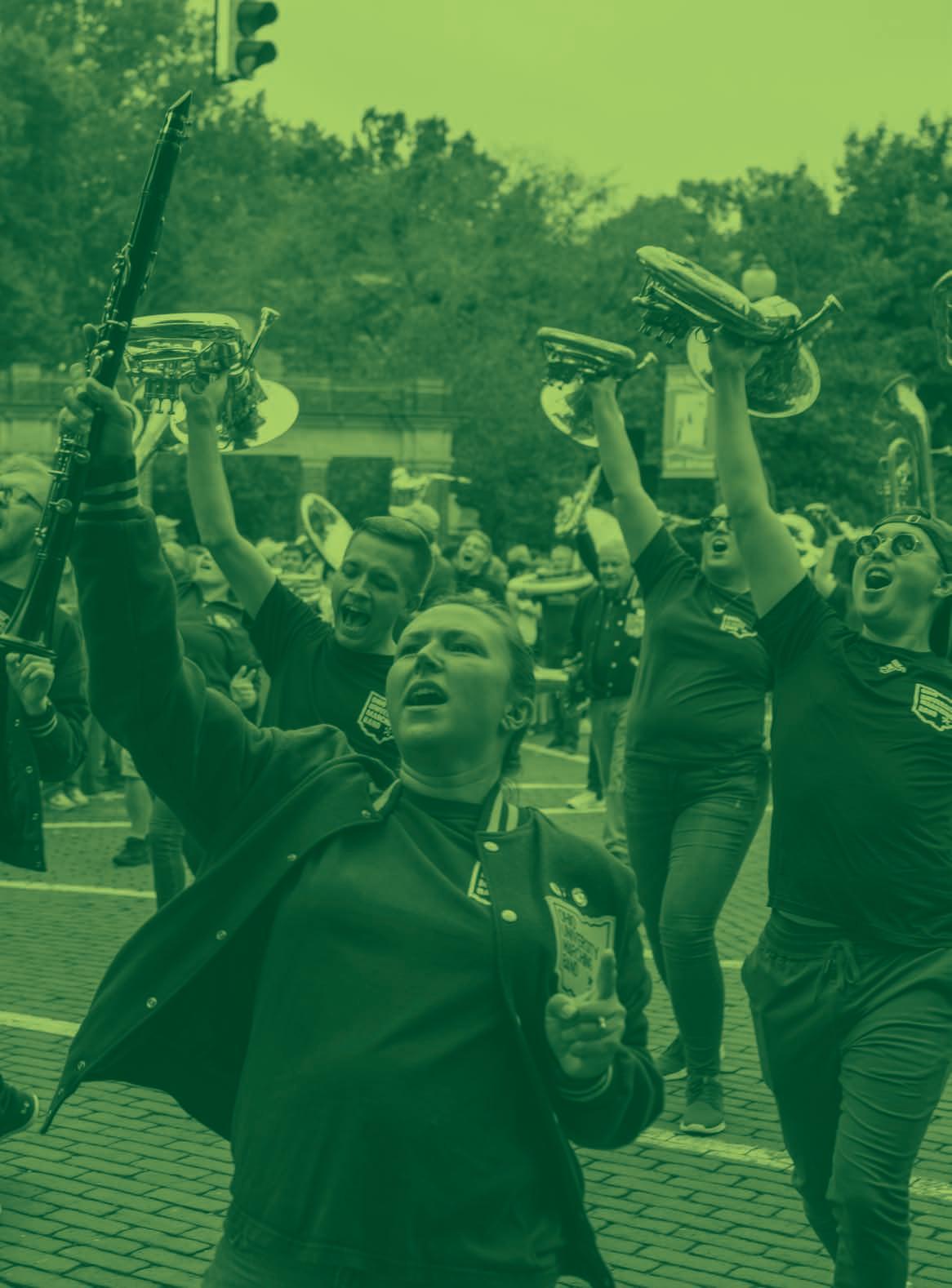
Lionel Borkan, AB ’46
Dolores M. (Senkfor) Kirby, BSJ ’47
Ruth M. (Bruss) Fondi, BSED ’49
Charles L. Horn, BSCOM ’49
Marilyn E. (Murphy) Huston, AB ’49
Robert H. Morehead, BSCOM ’49
Carl A. Schrader, BSCOM ’49
Virginia G. (Sisk) Silliman, BSS ’49
Carolyn (Hoffman) Gilbert, BSED ’50
William D. Graham, BSED ’50, M ED ’54
Robert L. Keys, BSED ’50
Richard M. Keys, BFA ’50
Robert V. Pierre, BS ’50
Raymond W. Hurd, BSED ’51, M ED ’57
William H. “Bill” Fields, BSAGR ’52
Carol M. (Flugan) Fields, AB ’52
Charlotte (Lotter) Milstead, AB ’52
David E. Schleif, MFA ’52
Mary E. Schmidt, BSED ’52
Joan (Herrold) Wood, BSJ ’52
Paul E. Cawein, AB ’53
Larry F. McArthur, BSCOM ’53
Lyndall (Grandstaff) James, AB ’54
Carlton W. Schramm, BFA ’54
Patricia S. (Yates) Bell, BSED ’55
Hugh W. Gillilan, AB ’55
Glenva “Babe” (Hunt) Anderson, BSED ’56
John E. Dalton, BSAGR ’56
Barbara J. Hilton, BSED ’56
David J. Lambert, BSCE ’56
Robert F. “Bob” Wenger, BS ’56
William E. Brown, BS ’57
Donald W. (Christensen) Christy, BFA ’57
Burton A. Milter, AB ’57
Terry W. Perkins, BSJ ’57
John M. “Jack” McMahon, BFA ’58
Peggy J. (Anderson) Montgomery, BSED ’58
Saul D. Timens, BSCOM ’58
Phillip R. Trimble, AB ’58
Richard O. Bell, AB ’59, MFA ’62
Richard D. Cumberland, BSED ’59
Dale J. Fazekas, BSIT ’59
Arnold E. “Arnie” Hannahs, BSME ’59
Janice L. (Story) Lochary, BSHEC ’59
Lowell “Dave” Massie, BSEE ’59
Betty Jean (Zyp) Thayer, BFA ’59
Richard E. Warman, BSCOM ’59
Barbara J. (Voros) Wolpert, BSJ ’59
John R. Bladowski, AB ’60
Harvey J. Breverman, MFA ’60
Alan F. Brooks, BSCOM ’60
Janet (Rife) Fulton, BSED ’60
Robert M. “Bob” Marquette Jr., BA ’60
Polly A. (Peters) Petroff, BSED ’60
Mary Ann (Smith) Wise, AA ’60, BSED ’62
Doris “Dottie” (Thompson) Emde, BSC ’61
Thomas R. Fox, BSCE ’61
Roger A. Remlinger, AB ’61
Ronald A. Scheurer, BSCOM ’61
Charles U. Spore, BFA ’61, MFA ’63
Jimmy E. Wallace, BSED ’61, MED ’71
John R. Burg, BS ’62
Gary C. Gould, BSED ’62
David B. Hadley Jr., BSED ’62
Margaret A. (Van Sickle) Lyon, BSED ’62
Rona S. (Canner) Simon, BSED ’62
Jerry D. Wilson, BS ’62, PHD ’70
Janet (Gordon) Bay, MED ’63
Jean Ann (Prather) Black, BSED ’63
Judith A. (Davies) Day, BFA ’63
J. Walter Dragelevich, BBA ’63
Sandra “Sandie” (Van Drew)
Johnson, AB ’63
David A. Young, MA ’63
Karen J. (Kelch) Helin, BA ’64
Denis P. Hunady, BSJ ’64
Teresa “Teri” (Wagner) Jones, BSED ’64
Barbara (Ruggles) Kranz, BSED ’64
Thomas R. Van Oss, BBA ’64
Charles E. “Chuck” Bremer, BSED ’65
Roger L. Moebus, BS ’65
Terence J. Murray, BSED ’65
Kermit F. Nance, BSED ’65
Marjorie A. (Polivka) Strom, BSED ’65
Ellen L. (Leopold) Williams, BSED ’65
Elaine (Koncsol) Young, MA ’65
David P. Baker, BSED ’66
Nancy (Cunningham) Cassis, AB ’66
Edward Gerhold, BBA ’66
Alan R. Guttridge Jr., BSJ ’66
John W. McGovern, BBA ’66, M BA ’68
Douglas L. Brown, BBA ’67
Sue A. Burggraf, AB ’67
Cheryl L. (Slater) Corbett, AB ’67
Charles T. Hess, PHD ’67
Francis N. Hinchey II, MS ’67
Jack M. “Mike” McElroy, BSED ’67
Philip M. Roberts, BSCE ’67
Marilyn “Joan” (Dalton) Rumer, BSED ’67
Junius B. “Jay” Stone III, BS ’67
Kenneth B. Williams, MED ’67
Elaine (Langhorst) Dickman, AB ’68
Thomas A. Gilliotti, BSED ’68
Gordon K. Huddleston, MBA ’68
Gary E. Keeton, MED ’68
Marshall C. Spradling, AB ’68
Richard J. “Rick” Vesler, BS ’68
Peter M. Ferry, AB ’69
David G. Foulds, MA ’69
Paul A. Gade, MS ’69, PHD ’74
Richard L. “Dick” Hayes, BSED ’69
Gerald W. “Jerry” Hensley, BBA ’69
Sharon M. (Devoe) McFarland, BSED ’69
Judith (Ferguson) Neff, BSHEC ’69
James S. Polen, BBA ’69
Joel T. Smith, BBA ’69
Richard E. Warren, BSEE ’69
Robert D. Wilsterman II, BSJ ’69
Jean E. (Roush) Wolfe, BSED ’69
Richard L. Bodner, PHD ’70
Anne L. Carroll, AB ’70
Phyllis E. (Elliott) DeGarmo, BSED ’70
Randall “Randy” Hoffman, BA ’70, BSED ’75, MED ’87
Richard W. Martin, BSEE ’70, BBA ’72
Rebecca B. (Walton) McCray, BSHEC ’70
Stephen Ruetschi, BSEE ’70, MBA ’72
Marilyn (Greenawald) Stevens, BSED ’70
Joseph V. Ugran, BBA ’70
Stanley J. Abel, MED ’71
Joseph A. Blaney, BBA ’71
George N. Boyer, BSED ’71
Michael K. Brown, BS ’71, MSISE ’77
Jacquelyn “Jackie” (Crown) Crow, BFA ’71, MED ’81
Margaret “Maggie” (Lewis) Davis, BSED ’71
Rolland C. “Rollie” Johnson, PHD ’71
Marianne Kindregan, BSHSS ’71, MA ’72
Sze Wai Leung, BSEE ’71
Betty L. McCoy-Bower, BSED ’71
Michael D. Miller, BSIT ’71
Thomas O. Miller, BSED ’71
Joan E. (Fette) Bayer, BSED ’72
William H. “Bill” Carpenter, BSME ’72
Thomas H. Eddy, BGS ’72
Arnold Kovalo, BFA ’72
Thomas E. Marx, BSED ’72
Michael R. McCormack, BMUS ’72
James J. “Jeff” Murray, BGS ’72
Elizabeth “Lynn” (Hogan) Patterson, BSED ’72
Joeleen M. (Ubbing) Schneiter, BSED ’72
Patricia A. (DeMatte) Van Beneden, BSED ’72, MED ’80
Dalton S. Alexander, BGS ’73
Eric W. Benedum, BSED ’73
Michael F. Collins, BSED ’73
Robert K. Edmundson, BGS ’73
Stephen A. Gary, BBA ’73
Mark D. Jackson, BSED ’73
Jeffrey P. Kent, BGS ’73
Jerry B. McGuire, AAS ’73, BSN ’77
Leilani (Hodson) Popp, BSED ’73
Patricia A. (Riley) Carpenter, BSHEC ’74
Sandra L. Fish, BSJ ’74
Diane J. (Highland) Hohman, BSED ’74
Frances (Smith) Lee, BSED ’74, MA ’79
Joseph C. Wiles, BGS ’74
Barry K. Cheney, AB ’75, BSED ’78
Mary Ann “Mame” Greulich, BSC ’75
Ty H. McCunn, BSED ’75
Michael D. Pool, BSIT ’75
Karen (Whitmore) Rieder, MED ’75
Ronald G. Anderson Sr., BSED ’76
Stuart E. Auld, BFA ’76
Arthur E. Cheloff, BBA ’76
Melissa A. Higgs-Horwell, BSED ’76
Kim W. Jackson, BBA ’76
Alan B. O’Leary, PHD ’76
Lucille “Marti” (Martel) McNamara, BFA ’77
Mark S. Perry, BS ’77
George W. Henderson, BSED ’78
Carolyn L. Iles, BSED ’78
Carol J. (Myers) Burriss, BSHEC ’79
J. Loretta (Collins) Hafer, BSN ’80
Kenneth D. Kusmer, BSJ ’81
Teresa S. (Bowman) Moore, BSN ’81
Shane E. Jenkins, BSJ ’82
Brian T. Eaton, BBA ’83
Jane M. Eddy, MED ’83
Robert H. “Bob” Forbes, MA ’83
Cindy L. Sturgeon, AA ’83
Frederick L. Armstrong, MBA ’84
Virginia “Gini” (Shepherd) Fink, BSN ’84, MA ’86
Von T. George, BBA ’84, MBA ’19
Heon Kim, MBA ’84
Leslie R. (Sandor) Potts, BBA ’84
George “Keith” McDonald, BSME ’85
John S. Brenner, BBA ’86
Thomas L. Fries Jr., BSC ’86
Robert D. “Rob” Livchak, BSRS ’86
Gerald E. “Gary” Loveday, BBA ’86
John “Jack” D. Agricola, PHD ’87
Thomas W. Swanson, BBA ’87
Laurie L. (Fannin) Torrence, BSED ’87
Wendell R. Walker, BSRS ’87
John C. Oakes, BBA ’89
Leslie A. (Tucker) Weiser, BSC ’89
Deborah A. Knuth, BSRS ’90
Mark R. Michel, BSSPS ’91
Kara L. (Krismanth) Armstrong, BS ’94
Stephanie A. (King) Eales, AB ’94
Michael A. Katz, AB ’94
Shawn C. Klomparens, AB ’94
James Dong Song, BBA ’94
Jo Ann Davidson, HLLD ’95
Douglas M. Engleka, BBA ’95, MSA ’96
Geoffrey A. Turk, MSPE ’95
Wendy L. (Elwood) Young, AB ’95
Rebecca A. (Goodman) Myers, AA ’96, BSS ’03
David Hardbarger, AAS ’99, BCJ ’03
Ann E. Morrison, BSHSS ’01
Adam L. Wellspring, BA ’06
Brandon S. McCollister, BBA ’09
Clinton A. Barnard, AAB ’12
Jessica (Ross) Sheehan, BA ’13
Adam L. Lubic, BBA ’14
Ava S. Willford, BSC ’18
Nathan Diebel, BA ’19
Charles G. “Chuck” Atkins, Athens, Ohio, associate professor emeritus of biomedical sciences, Aug. 11
Timothy R. Barnes, AA ’62, Athens, Ohio, former Body Donor Program director, Aug. 18
Michael S. Braasch, BSEE ’88, MSEE ’89, PHD ’92, Athens, Ohio, retired director of Avionics Engineering Center and professor of electrical engineering, Sept. 22
Donna L. Bruce, Athens, Ohio, retired administrative assistant, Oct. 5
Ronald L. Cappelletti, Montgomery Village, Maryland, professor emeritus of physics, July 6
Robert D. “Pete” Clark, Albany, Ohio, retired assistant director of maintenance and operations, Sept. 6
Fred E. Cremeans, BBA ’63, The Plains, Ohio, retired accounts receivable supervisor, Aug. 25
Samuel R. Crowl, Athens, Ohio, trustee professor emeritus of English, June 16
Erik H. Forrest, San Diego, California, associate professor emeritus of art, Oct. 16
Michael Grubbs, Albany, Ohio, relief maintenance shop, Aug. 5
Nancy K. “Birdie” Henry, BA ’17, MSW ’18, Lancaster, Ohio, former adjunct instructor, Oct. 8
Rosemary (Ooigkaas) Huntsman, AB ’73, Athens, Ohio, former administrative assistant, May 21
Thomas Johnson, Somerset, Ohio, emeritus Rural Outreach Executive in Residence, Oct. 30
Dennis Kish, Nelsonville, Ohio, retired maintenance repair worker, Oct. 2
Bentley A. “Andy” Krause, MSPE ’95, Athens, Ohio, former assistant professor, June 28
Bruce E. Kuhre, Athens, Ohio, professor emeritus of sociology and anthropology, Feb. 21
James A. Lavery, Davie, Florida, professor emeritus of health and sport sciences, Sept. 25
Robert Lee, Shade, Ohio, retired steamfitter, June 25
Rosemary L. Mayronne, Athens, Ohio, retired records management assistant, July 21
William A. McCammon, Athens, Ohio, retired building services manager, May 2
Malcolm C. Modrzakowski Jr., The Plains, Ohio, former associate professor of microbiology, Sept. 27
Margaret V. (Chapman) Morris, Blacklick, Ohio, retired cook, June 17
John P. Peerey, New Marshfield, Ohio, retired groundskeeper, May 27
Ganas K. Rakes, Highlands Ranch, Colorado, professor emeritus of finance, July 18
Ron Reed, Ashland, Kentucky, former head basketball coach at OHIO Southern, July 25
Marian R. (Engler) Rosenberg, BSHEC ’78, Kettering, Ohio, former employee, July 6
Diana L. Rudolph, Albany, Ohio, retired custodial worker, June 17
Carl L. Savage, Athens, Ohio, former project manager, Sept. 7
Frederick “Scrap” Savage, Millfield, Ohio, retired storekeeping supervisor, May 5
Robert F. Sharp, Asheville, North Carolina, associate professor emeritus of accountancy, May 28
George Sherman, Athens, Ohio, professor emeritus of theater, July 5
Folden “Burt” Stumpf, Wilsonville, Oregon, professor emeritus of physics, May 13
Beverly A. (Bowen) Workman, AIS ’93, BSS ’97, Athens, Ohio, retired assistant director of university publications, Aug. 27
Julitta “Lita” Young, Athens, Ohio, retired library associate, Aug. 21
David M. “Matt” Zuefle, Charlottesville, Virginia, former assistant professor, July 9
—Includes individuals who passed away between May 1 and Oct. 31, 2024. Information provided by the University’s Office of Advancement Services and staff research.
Send your updates to ohiotoday@ohio.edu or to OHIO Today Magazine , Ohio University, P.O. Box 869, Athens, OH 45701-0869.
MISSION STATEMENT
OHIO Today Magazine informs, celebrates and engages alumni, faculty, staff, students and friends of Ohio University.
Editor in Chief
Emma Frankart Henterly, BSJ ’10
Art Director
Sarah McDowell, BFA ’02
Contributors Advancement Services Operations Team
Laura M. André
Dylan Benedict, BSVC ’22
Eli Burris, BSJ ’16
Taylor Connelly, BSJ ’26
Douglas Dennis
Jen Jones Donatelli, BSJ ’98
Rich-Joseph Facun, BSVC ’01
Matt Love, MFA ’18
Anita Martin, BSJ ’06 Office of the University Registrar Ohio University Mahn Center for Archives & Special Collections
Ohio University Press
Sam Pelham, BA, BSJ ’17, MAA ’21
Mary Reed, BSJ ’90, MA ’93
Ben Wirtz Siegel, BSVC ’02
Emma Snyder-Lovera, BSJ, BSC ’26
Julia Weber, BSJ ’25
Ty Wright, BFA ’02, MA ’13
Vice President of Advancement and President/CEO of The Ohio University Foundation
Gregory Simmons
OUAA Executive Director
Jennifer Shutt Bowie, BSJ ’94, MS ’99
Vice President for University Communications and Marketing
Robin Oliver
Director of Content Strategy and Publications
Sarah Filipiak, BSJ ’01, BS ’23
Printer
The Watkins Printing Co.
OHIO Today Magazine is published two times a year. Its digital companion is ohio.edu/ magazine. Both are produced by University Advancement, with funding from The Ohio University Foundation. Views expressed in them do not necessarily reflect the opinions of the staff or University policies.
Editorial office address: OHIO Today Magazine, Ohio University, P.O. Box 869, Athens, OH 45701-0869. Send questions, comments, ideas and submissions to the above address, via email to ohiotoday@ ohio.edu, or by calling 740-593-2684. Make address changes at ohio.edu/alumni or by mail via Ohio University, Advancement Services, P.O. Box 869, Athens, OH 45701-0869. Send details for the “In Memoriam” section to the latter or advinfo@ohio.edu.
Copyright © 2025 by Ohio University. Ohio University is an equal access, equal opportunity, and affirmative action institution.



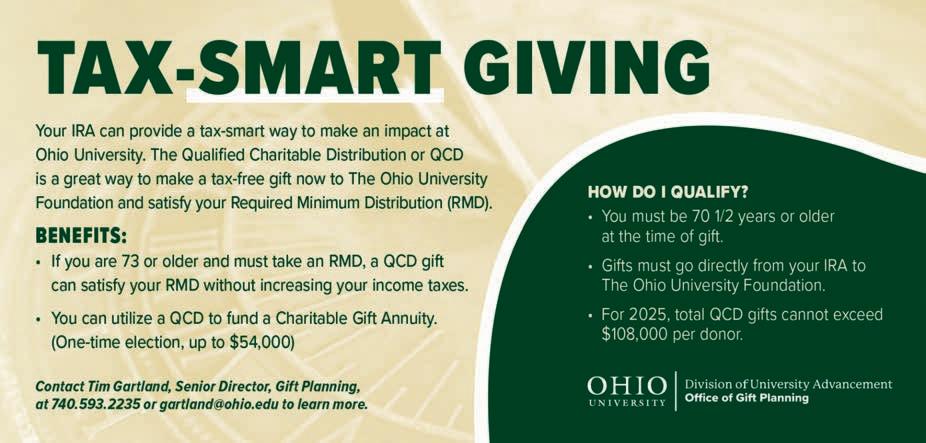
Nukhet Sandal, associate dean and political science professor in the College of Arts and Sciences, is an expert in her field. She is the editor-in-chief of the Oxford Research Encyclopedia of International Studies, and her impressive work in foreign policy, international conflicts and Middle Eastern politics have earned her numerous awards. This year, Sandal was one of 26 emerging leaders nationwide named to the prestigious American Council on Education (ACE) Fellows Program.
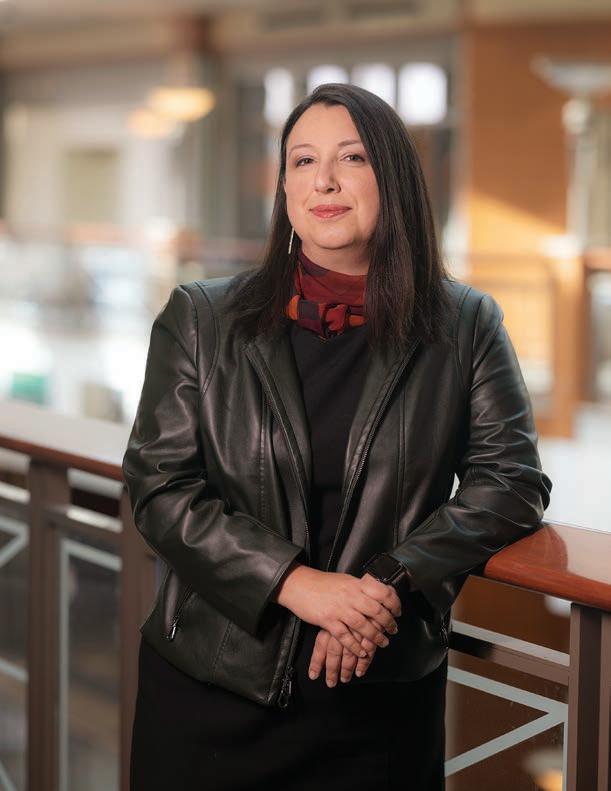
What can you tell us about the project component of your ACE fellowship? I am looking at best practices around the nation to help us provide opportunities for our students to have high-quality, handson experiences and mentorship, especially from alumni.
Did you always want to work in higher education? I actually studied a few years of dentistry. I have zero hand skills, and it was going really badly. A few mentors told me I wasn’t cut out for it. It was hard, at the time, to hear that and to quit. But since that day I have never felt like I was actually working; I love what I’m doing. At the time it felt like a failure, but it was the best decision ever.
Can you describe your teaching philosophy? I see students as junior colleagues; it is not a hierarchical relationship. I sit down with every student to discuss their goals for the class and preferences for being evaluated. I have a grading menu with suggested projects: movie reviews, papers, exams. That has been really well-received; students appreciate having a say.
How did you end up at OHIO? I chose OHIO because people are amazing here, and we have a strong international community. I love seeing the emphasis we put on everybody belonging. If you come from a different country, great! Come be part of our community. —Emma Snyder-Lovera, BSJ, BSC ’26
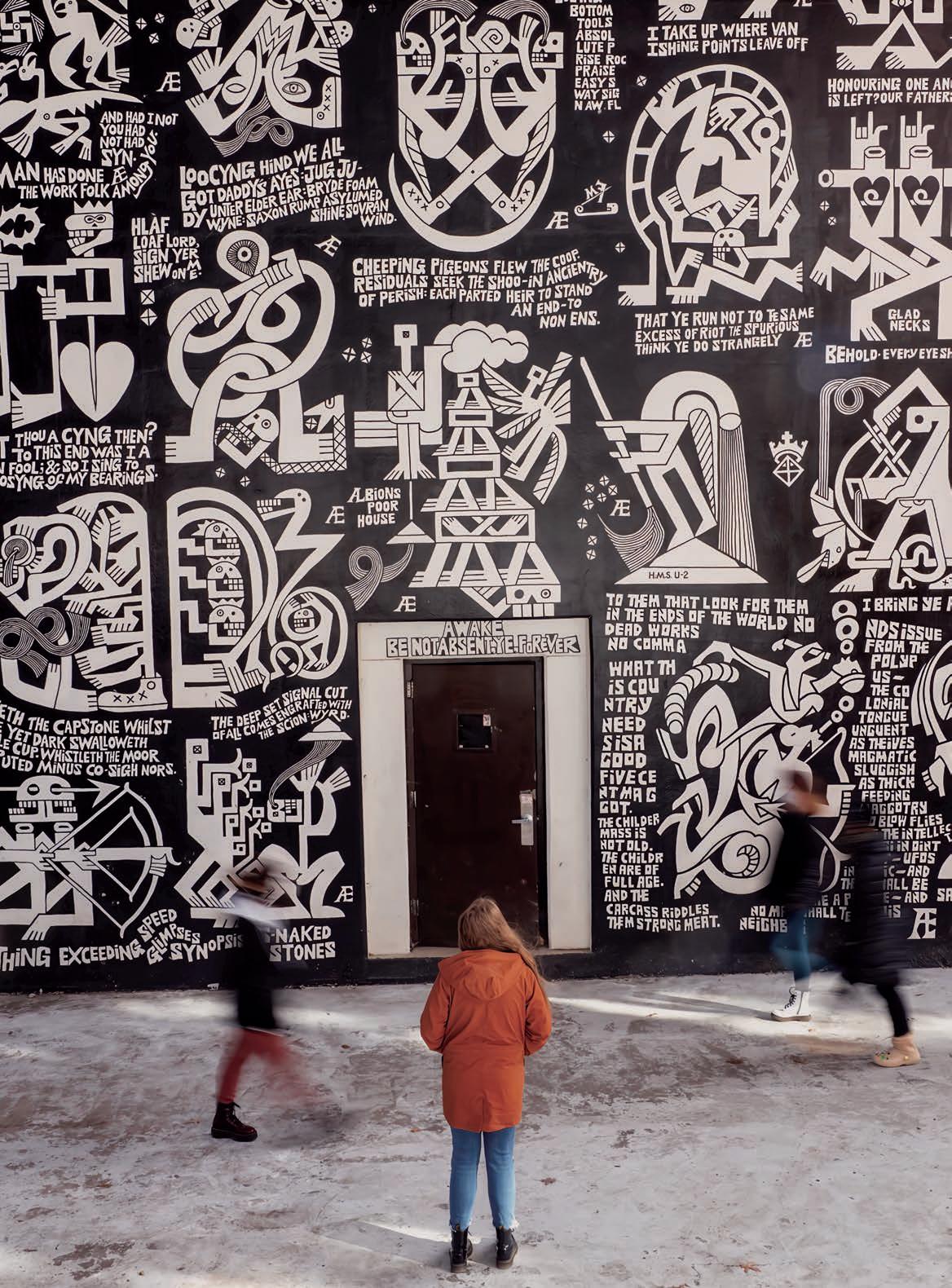
The Chaddock + Morrow College of Fine Arts Capital Project—a $94 million comprehensive facilities renewal—is underway, with construction of the new Patton Center for the Arts and full renovation of Seigfred Hall beginning earlier this year. (Both are scheduled for completion in fall 2026.) University leadership has actively sought to preserve the culture of Seigfred, like the Aethelred Eldridge Mural painted on its exterior. The mural was first commissioned in 1965 and has seen several iterations since.
When a geomagnetic storm facilitated aurora borealis displays across much of North America last October, professional and amateur photographers alike got to work documenting it. A gallery that included this image of the northern lights above the Ohio University Observatory on The Ridges Green was the mostliked “campus beauty” post on social media—and one of the most popular Instagram posts overall—for the second half of 2024. PHOTO
